Comets are composed of frozen gases, rocks, and dust, and they remain from the creation of the solar system approximately 4.6 billion years ago. These celestial bodies follow elongated orbits around the Sun, which have extremely lengthy durations.
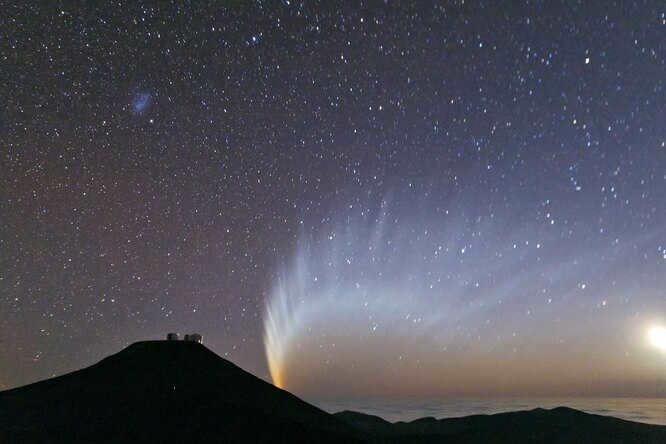
When a comet approaches the Sun, it undergoes rapid heating, causing the solid ice to transform directly into gas – a process known as sublimation. The gas comprises water vapor, carbon monoxide, carbon dioxide, and various other substances, which combine to form the distinctive tail of the comet.
According to NASA’s latest data in September 2021, the total number of identified comets stands at 3,743. It is believed that there are billions more comets in orbit around the Sun within the Kuiper Belt and the distant Oort cloud, situated well beyond the orbit of Pluto.
What are the components of a comet?
The core
A comet’s solid core is composed of icy molecules such as water, carbon monoxide, carbon dioxide, methane, and ammonia.
Coma
As the comet gets closer to the Sun, the frozen substances on the surface of the core start to transform into gas, forming a cloud known as the coma.
Around the coma, there is a hydrogen envelope that can extend up to 10 million kilometers in length. This envelope consists of hydrogen atoms and expands as the comet gets closer to the Sun.
Comet Tails
There are two primary types of comet tails: dust tails and gas tails. These tails are created by the interaction of sunlight and solar wind and always point away from the Sun. The solar wind pushes the small particles in the coma along a curved trajectory, forming the dust tail. The gas tail, on the other hand, is composed of electrically charged gas molecules. The coma and tails of comets reflect sunlight or emit their own light, allowing us to see them with the naked eye. However, most comets are either too small or too faint to be visible.
Trajectories of comets
Comets are categorized by astronomers based on the length of their orbit around the Sun. Comets with a short-period take approximately 200 years to complete one full revolution, whereas those with a long-period require more than 200 years. Additionally, there are comets that are not bound to the Sun and instead have orbits that extend beyond the solar system.
Furthermore, scientists have made the discovery of comets within the asteroid belt. These comets are believed to potentially serve as a significant water source for the planets within the Earth-group. It is theorized that short-period comets originate from the Kuiper belt, which is located beyond Neptune’s orbit. Through gravitational interactions with the outer planets, these comets are pulled inward and become active. On the other hand, long-period comets originate from the nearly spherical Oort cloud, which is even further away, and are drawn inward as a result of the gravitational pull from passing stars.
What are the names given to comets?
Comets are typically assigned names based on their discoverers. An instance of this is the Shoemaker-Levy-9 comet, which received its peculiar name due to being the ninth short-period comet discovered by Eugene and Carolyn Shoemaker and David Levy. Even spacecrafts remember, hence why many comets are named after missions such as SOHO or WISE.
TechInsider Network Edition
Founder of “Fashion Press” LLC: 119435, Moscow, Bolshoi Savvinsky per. 12, bldg. 6, floor 3, room II. 6, floor 3, room II;
Office address for editorial team: 119435, Moscow, Bolshoi Savvinsky per. 12, bldg. 6, str. 6, floor 3, room II; Office address for editorial team: 119435, Moscow, Bolshoi Savvinsky per. 6, floor 3, room II;
Chief Editor: Nikita Vasilenok
Email address for editorial team: [email protected]
Phone number for editorial team: +7 (495) 252-09-99
Information product rating: 16+
The online edition is registered by the Federal Service for Supervision in the Sphere of Communications, Information Technologies and Mass Media, registration number and date of decision on registration: series EL No. FS 77 – 84123 dated November 09, 2022.
© 2007 – 2023 “Fashion Press” Ltd.
By uploading content to the website, the User gives “Fashion Press” LLC the right to use, reproduce, distribute, create derivative works, and publicly display the content without any charge.
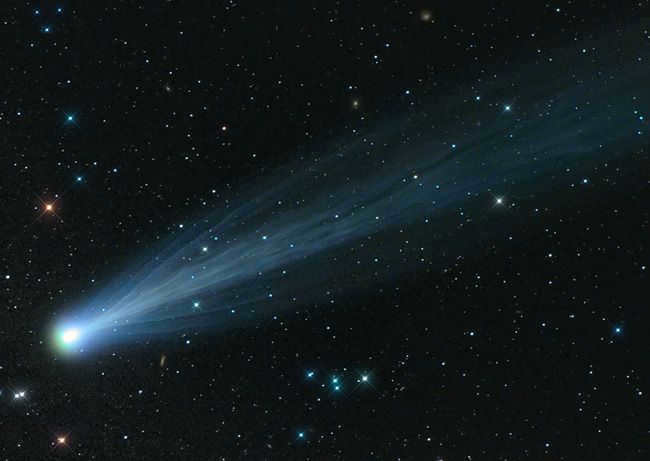
This week, one of the most exciting space events was the rendezvous between the European probe Rosetta and the comet 67P / Churyumov-Gerasimenko. While there have been other comets that have been visited by interplanetary vehicles, this particular encounter is highly significant and potentially historic.
The Rosetta mission is a natural progression of humanity’s fascination with comets, or “cosmatic” (komḗtēs) luminaries, as the ancient Greeks referred to them. In the following paragraphs, we will explore the knowledge that mankind has gathered about these cosmic “icebergs” and delve into the scientific community’s profound interest in studying them.
The history of documented observations of comets dates back thousands of years, with the most detailed accounts of these celestial phenomena found in ancient Chinese chronicles.
Even in ancient times, the appearance of comets was often associated with mystical and tragic events. For example, in 240 BC, a bright comet was seen as a sign of the imminent death of the Chinese empress. Similarly, a comet that appeared in the sky above Rome in 12 BC was believed to foretell the fate of Agrippa, a close friend and son-in-law of Emperor Augustus. In the 6th century, a comet was blamed for causing drought and disorder in Byzantium, and in 1066, it was seen as a clear omen of the invasion of England by William the Conqueror, Duke of Normandy.

Halley’s Comet depicted on a tapestry from Bayeux in 1066.
However, this celestial body was destined to play a crucial role in the history of scientific discoveries. In 1682, Edmund Halley, an English astronomer, calculated the trajectory of a brilliant comet that he had observed and noticed that it coincided with the paths of comets seen in 1531 and 1607. Assuming that it was the same comet, he made a prediction that it would reappear at its perigee (the point in its orbit closest to the Sun) in 1758.
The fact that Halley’s Comet appeared a month late in 1759 was sufficient evidence of the success of Newton’s theory of gravitation. Since then, Halley’s Comet has become the most prominent comet on the extensive list of observed comets. Its designation as 1P/1682 signifies that it is the first comet to make a “return” to the Sun, placing it in the category of short-period comets. The comet was initially discovered in 1682.
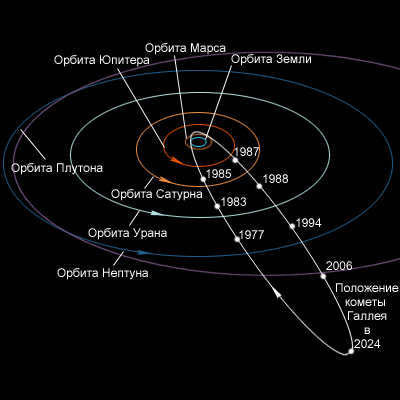
Orbital characteristics of Halley’s comet
Once again, thanks to Halley’s comet, which crossed the Sun’s disk in 1910, astronomers were able to estimate the approximate size of cometary nuclei, which was less than 20 km. Additionally, for the first time, a spectral analysis of the tail of the “cosmatic” celestial body was conducted, revealing its richness in poisonous cyanide and carbon monoxide. This caused a significant panic in the same year when the Earth passed through the comet’s tail, although it was ultimately unfounded.
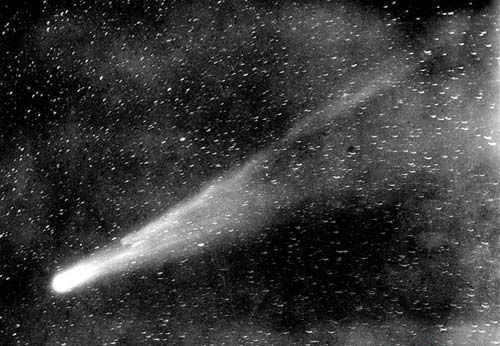
An image of Halley’s comet from 1910.
In 1986, when Halley’s comet returned, humans had advanced beyond just observing it from Earth (which was not a great year for observation). Instead, they sent a fleet of spacecraft to intercept the comet. This fleet, known as “Halley’s Armada,” consisted of the following:
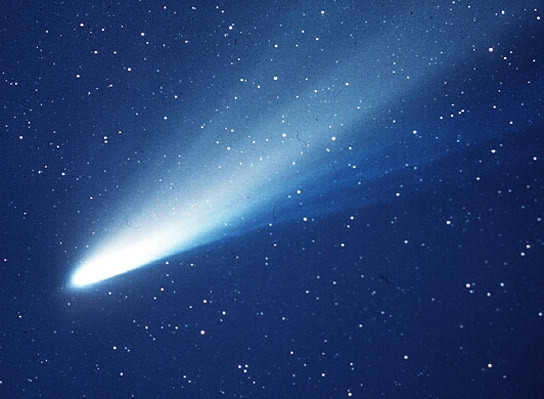
The passage of Halley’s Comet in 1986
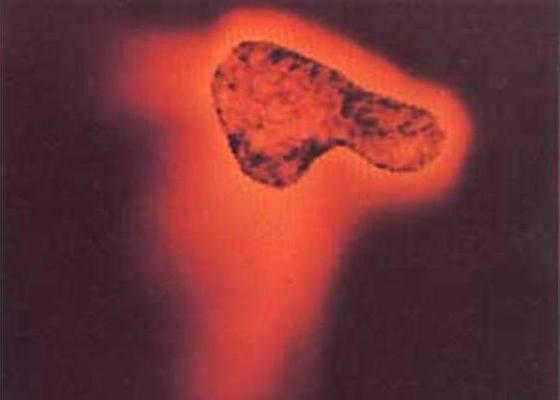
– The comet’s trajectory was explored by two Soviet probes named “Vega 1” and “Vega 2”, which flew approximately 9,000 km away from the nucleus. These probes successfully created a three-dimensional map of the nucleus and transmitted a total of 1,500 images (depicted below).
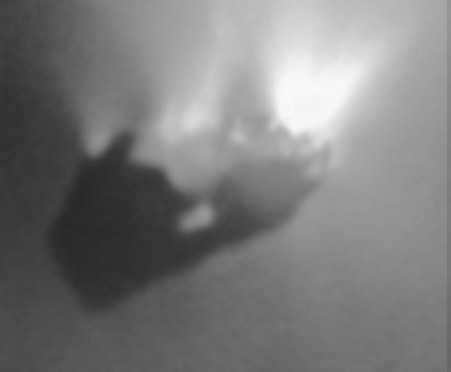
– The European probe Giotto, with the help of Soviet vehicles, was able to come within 605 km of the comet’s core (photo below).
– The nucleus was also approached by two Japanese probes, Suisei and Sakigake, at distances of 150,000 and 7 million kilometers, respectively.
– Another probe, ISEE-3 (ICE), observed Halley’s Comet’s tail from the Lagrangian point L1 in the Earth-Sun system.
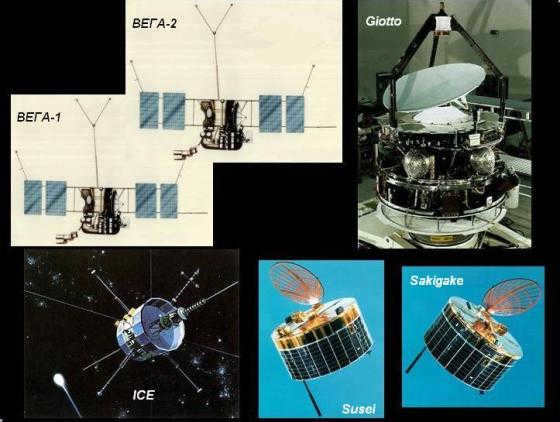
An image of Halley’s Armada studying the comet in 1986 is depicted here
A wealth of information about the composition of the comet was gathered, and numerous photographs of the nucleus were captured. The size of the comet’s nucleus, estimated to be 15/8km in irregular shape, confirmed previous observations made in 1910. This endeavor provided valuable experience in collaboration between various space agencies and in solving intricate technological challenges.
Regrettably, the “Year of Halley’s Comet,” eagerly anticipated by the scientific community, was overshadowed by two tragic events – the Challenger crew’s loss of life and the accident at the Chernobyl nuclear power plant.
Aside from Halley’s Comet, astronomers have documented thousands of comets observed in the last 300 years. The nuclei of these comets vary in size, ranging from a few tens of meters to tens of kilometers. Comets are composed of a combination of dust and ice, typically water, ammonia, and/or methane, which is commonly referred to as the “dirty snowball” Whipple model. However, it is evident that many comet cores deviate from this model to some degree. For instance, the Deep Impact space probe, which deployed a “shell” on comet Tempel 1 in 2005, revealed that the comet is primarily made up of a porous dusty structure.
The Deep Impact probe’s “bombardment” of Tempel’s comet and the subsequent flyby of the Stardust probe near the comet.
Comets, as the preserved fundamental components of the primary construction material of the solar system, hold a significant fascination for the fields of geology, chemistry, and biology. It is believed that comets played a crucial role in delivering the majority of the Earth’s hydrosphere water during ancient times. In the spectral lines of numerous comets, scientists have detected intricate organic compounds, including amino acids and urea. The hypothesis is that comets, acting as incubators for complex organic compounds, might have transported the chemical foundation for the origin of life on Earth.
As comets approach perihelion, they start emitting large amounts of gases due to the influence of solar radiation. This process bypasses the usual melting ice state and directly converts the ice into gas (sublimation). The gases then carry away significant amounts of dust that is mixed in the ice. Together with the ice particles, this dust is blown away in the opposite direction from the star, driven by solar radiation and wind.
These cometary “tails” can be incredibly long, reaching lengths of several hundred million kilometers. A notable example occurred in 1996, when the Ulysses space probe (NASA/ESA) unexpectedly passed through the tail of the Great Comet 1996 C/1996 Hyakutake… a staggering 500 million kilometers behind the comet itself!
Nevertheless, the orientations of comets’ tails do not consistently appear to be “linear” or oriented away from the Sun. The direction of the tail can vary based on factors such as the comet’s orbital characteristics, composition, the solar wind, or the interaction between the sun’s magnetic field and the ionized material of the celestial body. The tail can be oriented both perpendicular to the Sun’s radiation and in the direction of the solar radiation. Additionally, a single comet’s tail may consist of multiple parts with different orientations, or it could even resemble a colossal shell composed of gas and dust.
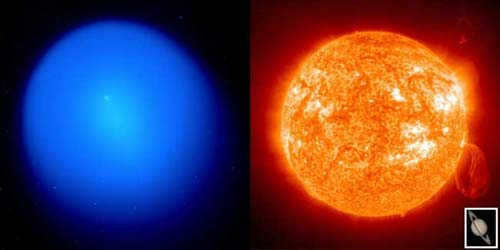
Comet 17P/Holmes demonstrates an unconventional structure of the gas-dust shell (coma) of a comet, as depicted by the relative sizes of its coma compared to the Sun and Saturn
Since 1995, comets have been categorized into different classes: P/ – Short-period comets, with an orbital period of less than 200 years. C/ – Long-period comets, with an orbital period of over 200 years. X/ – comets with unknown orbital parameters (historical comets). D/ – comets that have been destroyed or lost, and lastly class A/ – asteroids mistaken for comets.
The Shoemaker-Levy 9 comet collided with Jupiter in 1994. The comet was subsequently reclassified as a "death comet" belonging to class D/ 1993 F
The typical format for naming comets consists of a class index, which is usually preceded by the comet’s confirmed perihelion passage serial number and followed by the year of discovery. Additionally, a letter denoting half a month and a discovery serial number are included after the year of discovery. For instance, the letter A represents comets discovered in the first half of January, while Y represents comets discovered in the second half of December. The names of the discoverers are also listed at the end. As an example, the nomenclatural name for comet Churyumov-Gerasimenko is 67P/1969 R1. However, it is commonly abbreviated as (n)P/Discoverer’s name.
The category of “extreme comets” that pass in very close proximity to the Sun warrants particular consideration. They are typically identified by space probes that investigate our star, such as SOHO and the twin spacecraft Stereo A and B. It is hypothesized that the majority of these comets are remnants of a massive comet that disintegrated millennia ago (the Kreutz comet). It is widely believed that the majority of these comets are fragments of a single colossal comet that disintegrated thousands of years in the past (Kreutz’s comet).
The Planetary Harem of the King.
The majority of short-period comets are categorized into four major families based on their orbital parameters and the gravitational pull of the dominant giant planet in their system. Among these families, Jupiter holds the largest number of comets, and the following comets are considered to be under its dominion:
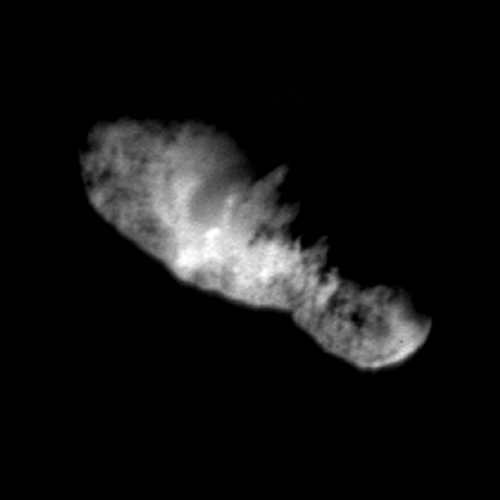
In 2001, the Deep Space 1 probe (NASA) explored 19P/Borelli, a comet that is part of the “family” that also includes comet 9P/Tempel (Tempel 1), which was visited by the Deep Impact probe (NASA) in 2010 (see animation below).
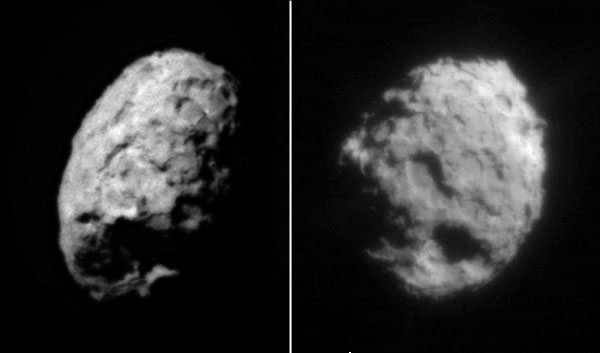
The Stardust probe (NASA) was able to collect dust samples from Comet 81P/Wilde and bring them back to Earth in 2006;
Comet 67P/Churyumov-Gerasimenko, which was studied by the Rosetta probe (ESA), also belongs to the “king” family of comets due to its characteristics.
Following that, we have the families of comets associated with Saturn, Uranus, and Neptune. Halley’s comet, which was mentioned earlier, is a typical example of a short-period comet from the Neptune family.
“Disorder” in the “stability” band
According to the prevailing theory among scientists, certain short-period comets originate from the outer regions of the Kuiper Belt, specifically the Scattered Disk (SD). The SD, along with the Kuiper Belt, consists of a vast collection of large icy bodies with sizes ranging from a few tens of meters to thousands of kilometers (such as Pluto and Charon). Spanning a distance of 35 astronomical units (the orbit of Neptune) to the outer boundaries of 50 a.u. (or 100 a.u. with EP), the belt possesses an estimated mass equivalent to 1-8 times that of the Moon (in comparison, the asteroid belt is no more massive than 0.04 times the mass of the Moon). Generally, the Kuiper Belt remains stable due to its orbital resonances with Neptune and the other objects within it.
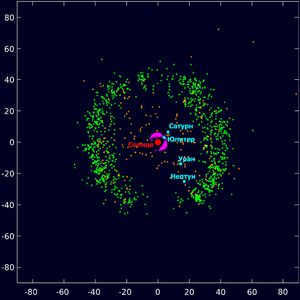
Chart illustrating the distribution of known objects in the Kuiper Belt (distance graph in astronomical units)
The current state of the Kuiper Belt and the Oort Cloud is believed to be the result of ancient movements of Neptune towards the outer regions of the solar system, influenced by the gravitational forces of Jupiter and Saturn. Some of the matter was expelled from the solar system, while others, along with the Oort Cloud, were pushed to its outer regions. Millions of other fragments were propelled towards the inner solar system, leading to a period of intense impacts known as the late heavy bombardment, which occurred approximately 4-3.5 billion years ago.
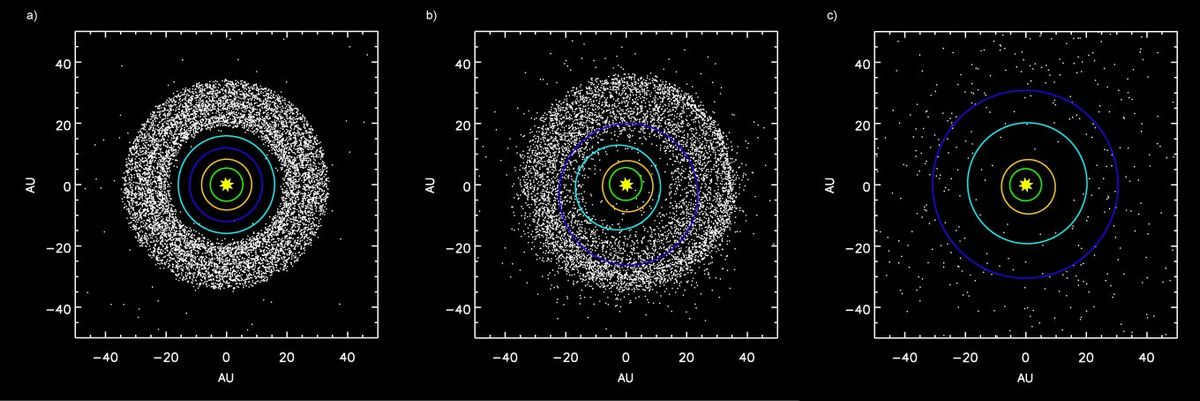
The arrangement of celestial bodies in the solar system changed when Neptune underwent its “migration.” Before the migration (depicted by the purple orbit in (a)), the system looked different compared to during (b) and after (c) the migration. The green orbit represents the path of Uranus.
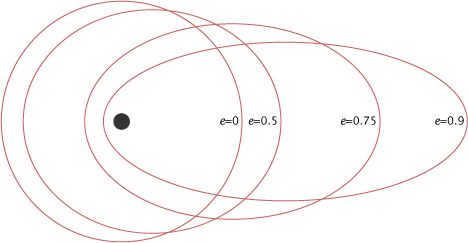
In order to understand the instability of the outer, scattered disk, we need to delve into the fundamentals of celestial mechanics. The orbit of a celestial body is characterized by two main parameters: apocenter, which is the point of greatest distance from the surface of a planet or star (in the case of a star, it is referred to as apogee), and pericenter, which is the closest point of the orbit (or perihelion in the case of orbiting around the sun). The difference between these values is known as the eccentricity of the orbit, which measures the degree of deviation from a perfect circle (e=0) to an ellipse (e>0, but 1).
Within the inner region of the solar system, specifically in the area where the Earth group planets and the asteroid belt are located, the velocity of orbital bodies is relatively high, reaching tens of km/s, while their eccentricities remain relatively low. As a result, a significant amount of energy is required to counteract strong orbital disturbances. On the other hand, at the outer boundary of the Kuiper belt, in the scattered disk, the orbital velocities of objects typically range from a few km/s to a few hundred m/s. This means that even minor gravitational perturbations or collisions can have a drastic impact on the eccentricity of these bodies. As a celestial object moves towards the inner part of the solar system, it experiences a noticeable increase in its apogelion (acceleration) or a decrease in its perihelion (deceleration).
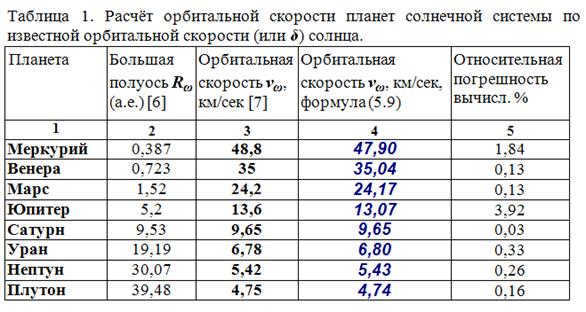
Is there a chart available that shows the differences in orbital velocity among various celestial bodies in the solar system? For example, the difference in orbital velocity between Mercury and Mars (both part of the Earth group), Jupiter and Neptune (both giants), and Pluto (part of the inner Kuiper belt).
Exploring space.
However, the prevailing belief in the scientific community is that most short-period comets belonging to the P/ class and all comets belonging to the C/ class originate from the hypothetical Oort Cloud. The inner region of this cloud takes the form of a toroidal belt that spans a distance of 2,000 to 20,000 astronomical units (known as the Hills cloud). It is estimated that this cloud has a mass of at least twenty-four times that of Earth.
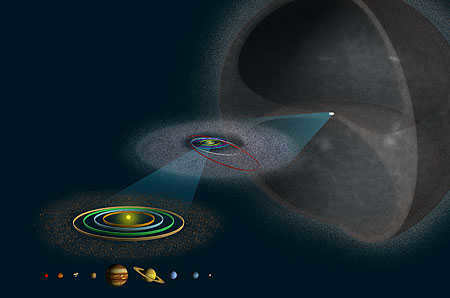
When comparing the sizes of the Earth-group planets’ orbits to the Kuiper belt, and the sizes of the Kuiper belt to the Oort cloud, we can see the vast differences in scale.
Hill’s cloud functions as a type of nourishment for the external, spherical cloud, which has a mass equivalent to several Earth masses and extends from a distance of 20,000 AU to 1 light-year, encompassing the gravitational boundary of the solar system (known as Hill’s sphere). The primary “supplier” of comets to the inner part of the solar system is believed to be the outer Oort cloud. These comets are likely remnants of the original “building material” of the solar system, making them highly significant in scientific research. The deceleration and acceleration effects, previously described for the Kuiper belt, are even more pronounced in this region due to the exceptionally low orbital velocities of the comets (measured in meters per second).
Some of the most famous long-period comets in recent years include comets C/1996 B2 Hyakutake, C/2006 R1, and C/2009 R1 McNaught. These comets, which originate from the far reaches of the Oort cloud, made their one and only appearance in our solar system before leaving on a hyperbolic trajectory with an eccentricity greater than 1.
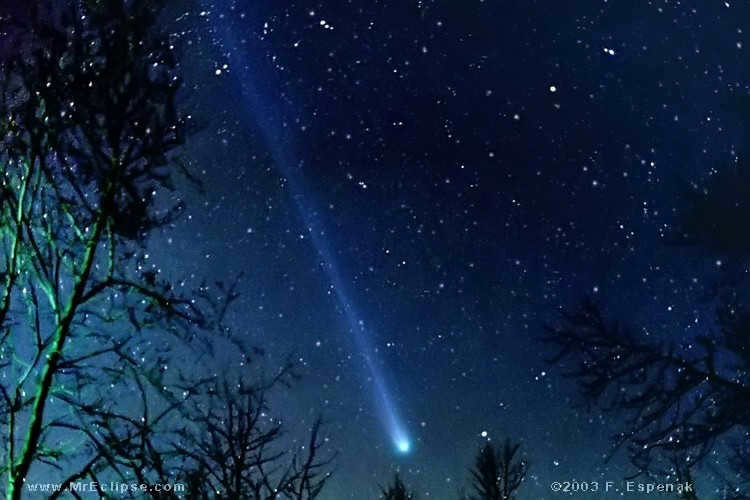
C/1996 B2 Hyakutake visible in the Earth’s atmosphere.
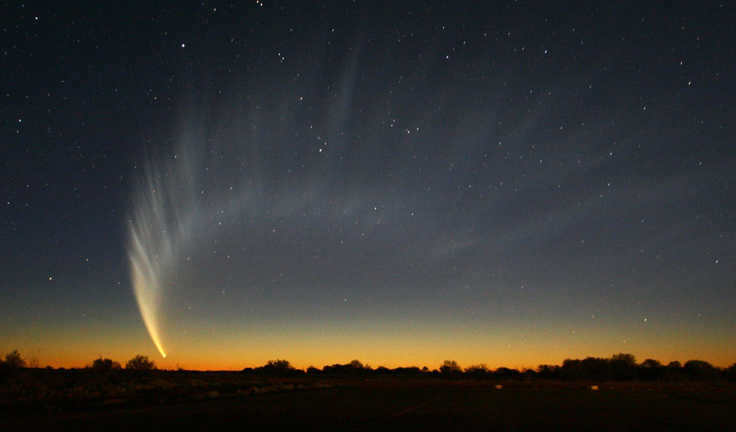
C/ 2006 P1 McNaught (“The Great Comet of 2007”) with another instance of an arched “irregular” coma
In 2010, Comet Elenin (C/ 2010 X1) had similar intentions, but the gravitational disturbance caused by Jupiter “dictated” the comet’s path within the solar system, reducing its eccentricity to less than 1 (with an apogee of approximately 500 astronomical units). The renowned “Great Comet of 1997” Hale Bopp (C/ 1995 01) only sought to make another honorary lap at its perihelion, which is nearly perpendicular to the Earth’s orbital plane. However, the unyielding force of Jupiter once again halved the comet’s perihelion distance, from 600 (with an orbital period of 4800 years) to 350 astronomical units (with an orbital period of 2400 years).
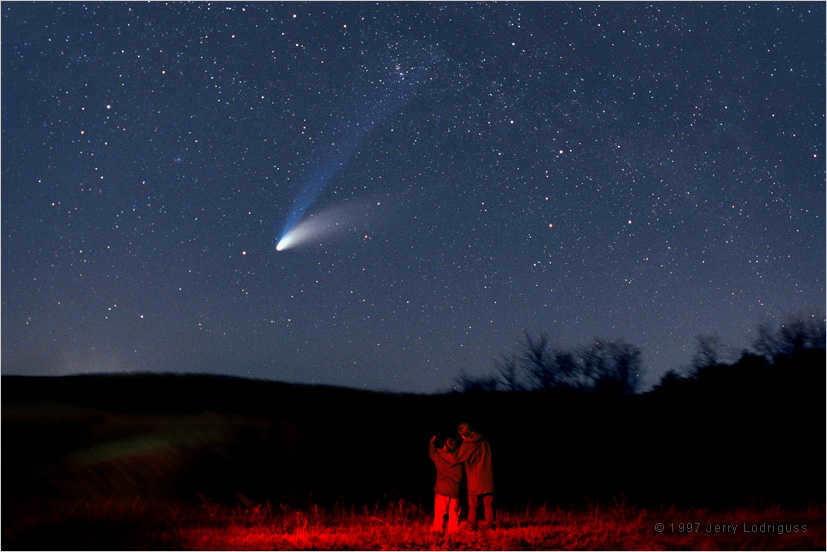
Hale Bopp’s “Great Comet of 1997.”
And possibly the most significant astronomical letdown of 2013 was comet ISON (C/2012 S1), which followed a parabolic path (e=1) from the outer regions of the solar system, only to disintegrate when it reached its closest point to the Sun.
Examining the orbital evolution of our well-known comet Halley, it was revealed that it also originated from the distant Oort cloud. The gravitational effects of the giant planets, similar to many other comets, pulled it into the family of Neptune’s comets. The comet’s orbit barely brushes against the Kuiper Belt at its farthest point (35 a.u.), but it comes closer to the Sun than Venus at its closest point, which is 88 million kilometers away. The next time the comet will reach its closest point to the Sun will be in 2061.
As a conclusion, I want to bring up the words of Mark Twain, who, like me, was born during the appearance of Halley’s Comet (although 150 years apart): “I entered this world with the comet and will depart with it too when it returns next year” (c) 1909. Indeed, Mr. Twain departed in 1910, along with Leo Tolstoy and the renowned Italian astronomer Schiaparelli. Admittedly, not the most dull companions for a journey through the solar system.
I genuinely hope that my readers will live to witness that significant moment, and may no man-made disasters or the demise of idols taint your sense of awe for the beauty of this famous celestial traveler.



Universe
What are comets?
Comets are massive celestial objects made up of frozen gases, rocks, and dust that, along with the other celestial bodies in the solar system, orbit around a star. They formed as a result of complex processes during the formation of the planets and the Sun. Initially, comets are quite large and can be as big as entire cities. However, as they orbit the Sun and get closer to the heat source, comets gradually warm up and lose mass throughout their life cycle.
Not only is the Sun responsible for heating comets, but it also has the power to draw in particles, causing massive tails that stretch across millions of kilometers and illuminate the void of space. The movement and trajectory of comets are guided by the gravitational pull exerted by the planets and stars they encounter. As a comet approaches the Sun, its speed increases rapidly due to the intensified gravitational force exerted by the nearby celestial body. Consequently, not only does the comet’s tail accelerate, but it also lengthens as more material is vaporized.
What is the reason behind the name “comets”?
The name “comets” was given to these celestial bodies due to their distinct appearance and tail. The word “κομήτης, komḗtēs” in ancient Greek means “tailed”, “hairy” or “kosmaty”.
Fascinating fact: A comet’s tail always points in one specific direction. While it may seem plausible to imagine these bodies with tails pointing in the opposite direction of their motion, in reality, the tail is always directed away from the Sun.
Scientists believe that there is a significant number of comets orbiting in the solar system. According to NASA’s official website, astronomers have documented a total of 3,595 comets to date.
History of Comets Studies
In ancient times, when people used to attribute mythological and divine characteristics to various phenomena, they also took notice of the peculiar luminous streaks that occasionally appeared in the night sky. Some even believed that these streaks were the souls of the departed.
However, as time went on, scientific thinking developed. Aristotle was the first to propose that comets were actually made up of luminous gas. Following his lead, Seneca hypothesized that these enigmatic celestial objects followed their own orbital paths.
Comets have a repeating orbit, bringing them back into view for astronomers time and time again. Theories concerning their elongated elliptical orbits were proposed, although it wasn’t until the 18th century that these theories gained widespread acceptance and confirmation. The initial hypothesis regarding this matter was put forth by the German scientist Georg Derffel in 1681. Just six years following the publication of his predecessor’s work, Isaac Newton sought to explain this phenomenon by introducing his groundbreaking laws of gravity to the world. Newton also posited that comets were composed of rocky material with ice, which would vaporize as they neared the Sun, resulting in the formation of a tail.

In 1705, Edmund Halley examined the recorded sightings of comets and made an effort to ascertain the characteristics of their paths using principles of Newtonian physics. This inquiry led him to propose the hypothesis that the comets observed in 1531, 1607, and 1682 were, in fact, the identical celestial body that would reappear 75 years after its last documentation. Halley achieved the remarkable feat of accurately predicting the reappearance of a comet – in 1759, the comet materialized precisely as he had calculated. It was subsequently named Halley’s Comet.
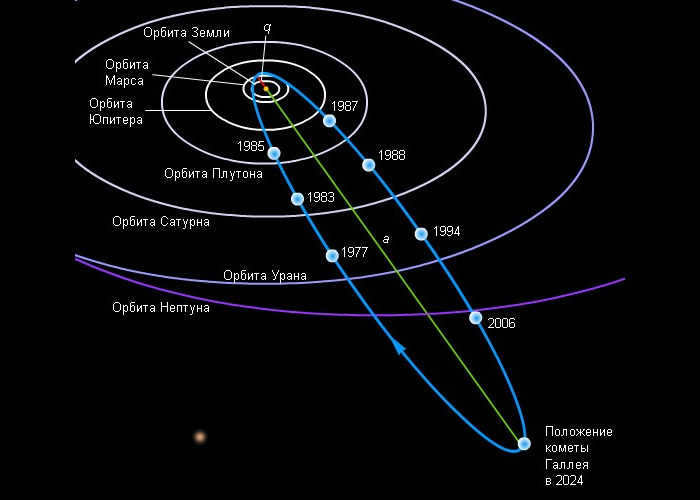

In the late 1800s, Italian astronomer Giovanni Schiaparelli presented his theory on the Perseid meteor shower, which is visible to the naked eye every August. This phenomenon is understood to occur because the Earth passes through a cloud of debris left behind by the Swift-Tuttle comet. This discovery led scientists to believe that comets possess a solid surface covered by a layer of ice.
In the 1950s, Fred Lawrence Whipple, an American astronomer, proposed that comets are primarily made up of ice rather than rock. He suggested that comets contain frozen water, carbon dioxide, and ammonia. Whipple’s theory was later confirmed by observations made by spacecraft launched in the latter half of the century.
Fascinating fact: Throughout history, comets have been interpreted as either signs of impending doom or as harbingers of good luck. For instance, the Roman Emperor Nero believed that a comet was a warning of his assassination, prompting him to kill all of his potential successors. Pope Callixtus III even attempted to excommunicate Halley’s Comet, believing it to be an instrument of the devil. Similarly, William the Conqueror saw the appearance of a comet as a positive omen before his invasion of England in 1066.
Comets: Understanding Their Structure and Composition
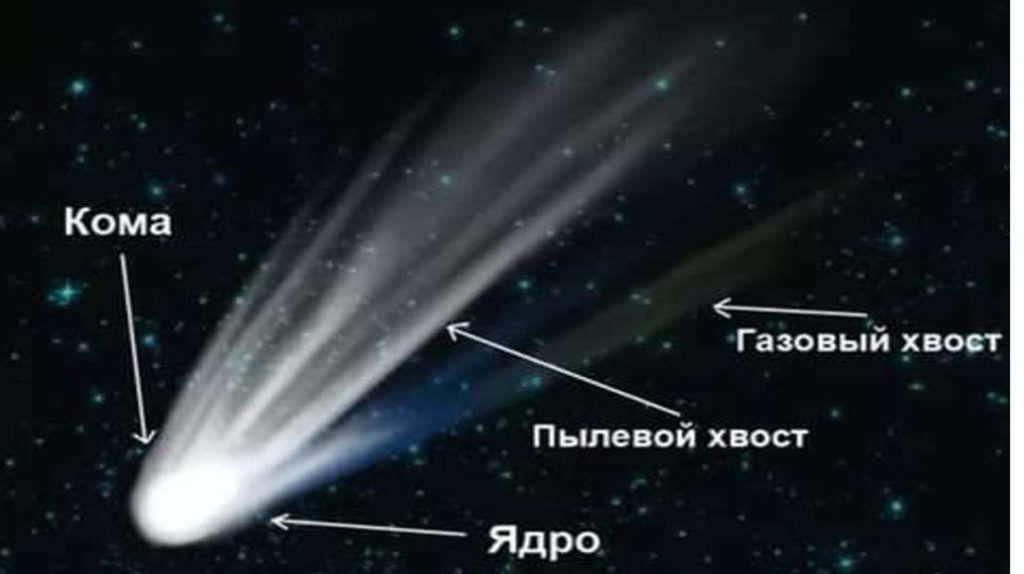
It is now understood that comets consist primarily of ice, which sublimates when the comet approaches the Sun. This process generates a luminous gas envelope containing charged particles known as ions, as well as dust particles made up of silicates, hydrocarbons, and ice. This envelope is referred to as a coma. The size of comet nuclei ranges from several tens of meters to approximately 60 km. The coma forms a shell around the nucleus, which can span millions of kilometers, and is surrounded by an even larger hydrogen shell.
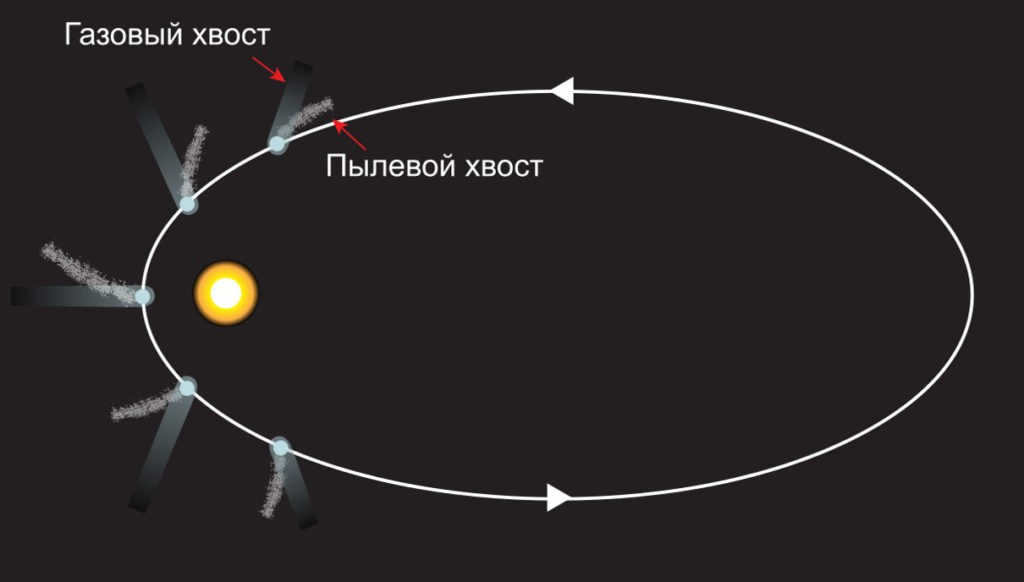
The combination of dust and vapor results in the formation of two distinct tails, which generally align in the same direction. Both tails always extend away from the Sun, but the charged particles are more influenced by the magnetic field and solar wind, causing them to point directly opposite to the star. Dust particles, on the other hand, are less affected, resulting in a curved direction for the dust tail that depends on the orbit of the comet.
Fascinating fact: In 2009, a NASA space probe collected a sample from Comet Wilda 2 and scientists discovered the presence of the amino acid glycine, a crucial component for the origins of life. A recent study proposes that a comet may have collided with Earth, delivering up to 9 trillion organic materials, thereby providing the necessary energy and materials for synthesizing more complex molecules that eventually gave rise to life.
What are the differences between comets?
Comets can vary from one another in terms of their mass and size. While they may differ greatly in size, comets are generally small in comparison to other celestial objects. If you have ever observed comets with an amateur telescope, you may have noticed that they also differ in terms of their luminosity and shape. These characteristics are primarily determined by the chemical composition of the comet.
The source of comets
The source of comets can be determined through their orbital characteristics. Comets with an orbital period of less than 200 years are thought to come from the Kuiper Belt. This belt, which was proposed by Dutch-American astronomer Gerard Kuiper in 1951, is located beyond Neptune’s orbit. It is estimated that the belt contains approximately 1 trillion comets.
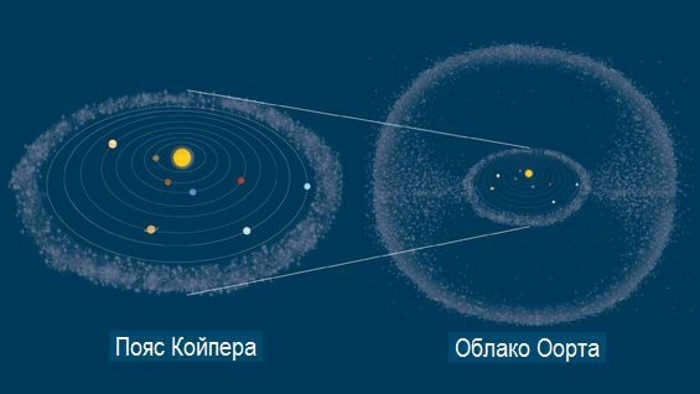
It is believed that comets with orbital periods exceeding 200 years originate from a region known as the Oort Cloud. The Oort Cloud is a spherical cloud that encircles the Sun at a distance of over 1.5 light-years from the outer edge of the Kuiper Belt, which is approximately one-third of the distance to the nearest neighboring star, Proxima Centauri.
In 1932, Estonian astronomer Ernst Epik first proposed the idea that comets with long orbital periods could originate from the Oort Cloud. This concept was further developed by Jan Oort in 1950. The Oort Cloud is estimated to contain hundreds of billions of comets, some of which may possess an ice content several times greater than the total amount of water on Earth.
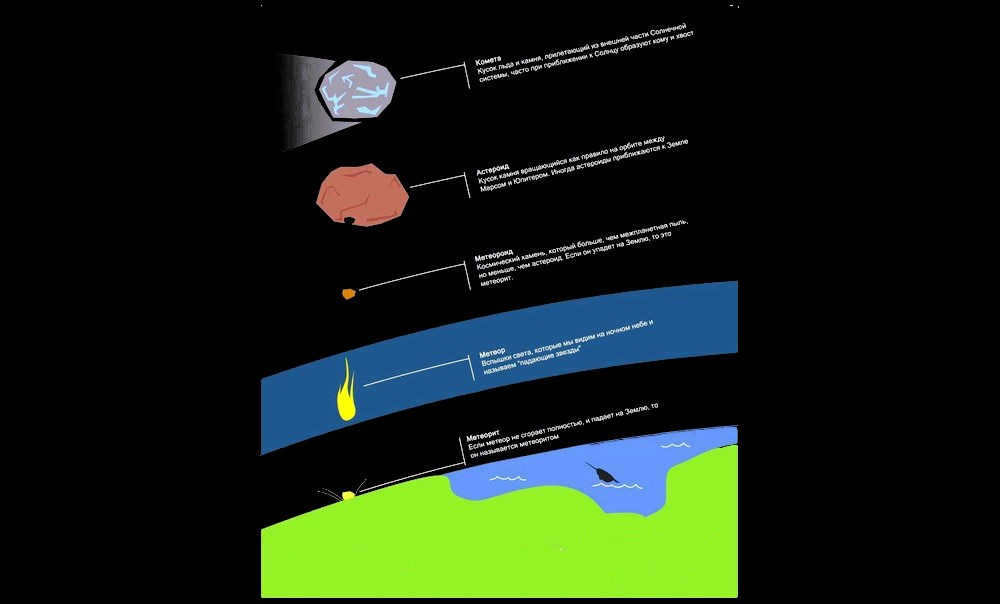
Meteors are often referred to as “shooting stars” due to the bright flashes they create in the sky. Meteoroids, on the other hand, are various objects in space that can range in size from tiny grains of dust to small asteroids. Essentially, they are rocks that are traversing through outer space. Once these meteoroids enter the Earth’s atmosphere, or even the atmosphere of another planet like Mars, and burn up at high speeds, they create fireballs or what we commonly call meteors. However, if a meteoroid manages to survive the journey through the atmosphere and lands on Earth’s surface, it is then classified as a meteorite. The distinction between a meteor and a meteorite is solely based on the size of the celestial object in question.
Minor planets, also known as asteroids, are rocky fragments that lack an atmosphere and were formed during the initial stages of our solar system’s creation approximately 4.6 billion years ago. These celestial bodies are primarily found in the region between Mars and Jupiter. Asteroids exhibit a wide range of sizes, with some reaching diameters of up to 530 kilometers, while others are as small as 10 meters. One key distinction between asteroids and comets lies in their chemical composition.
What is the process of naming comets?
The process of naming comets has evolved over the course of more than 2000 years. Different naming schemes have been implemented, resulting in some comets having multiple names.
In the early days, comets were named after the year they were discovered. For example, the Great Comet of 1680 was named based on the year it was observed. As time went on, astronomers agreed to name comets after the individuals associated with their discovery or the first comprehensive study conducted on them. This led to comets being named after people like Hale-Bopp and Halley, who made significant contributions to the understanding of these celestial objects.
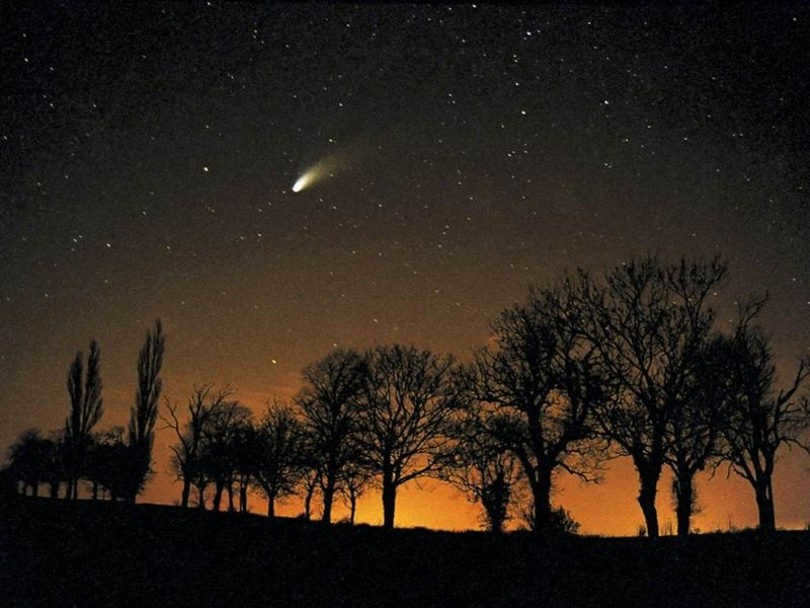
Ever since the 20th century, technology has been advancing rapidly and the number of scientific breakthroughs has been increasing every year. As a result, there arose a need for a more comprehensive system that utilizes special numbers.
In the beginning, comets were given codes based on the order in which they passed perihelion (for example, comet 1970 II). However, this system could not be sustained for long due to the overwhelming number of new discoveries each year. Consequently, a new system was implemented in 1994, wherein a code is assigned based on the type of orbit and the date of discovery (for instance, C/2012 S1):
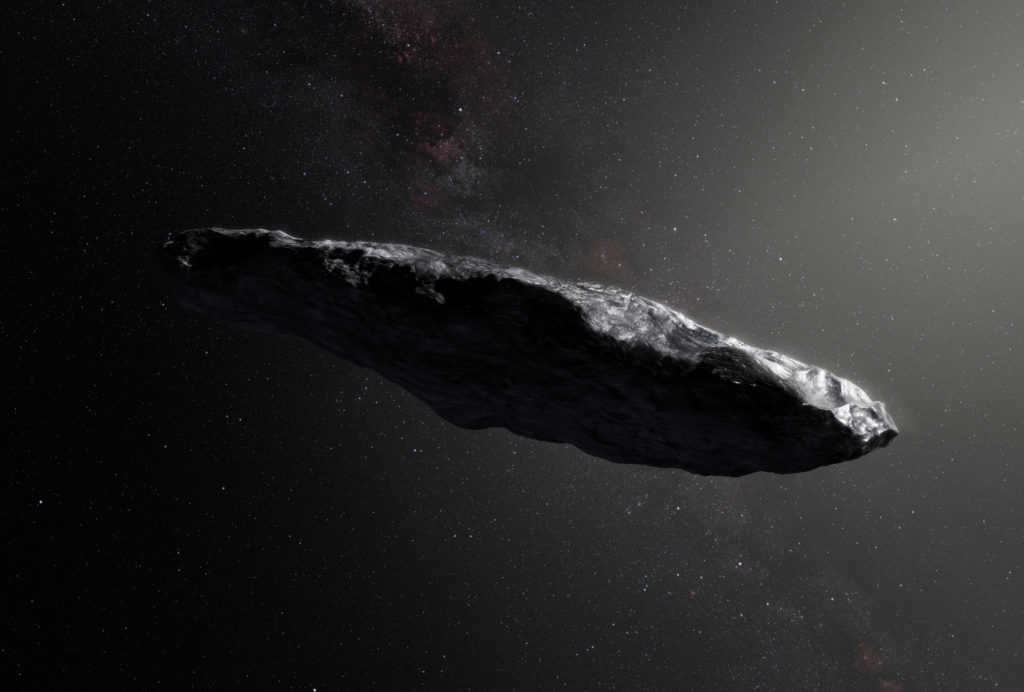
- P / stands for a periodic comet, which is defined as any comet with an orbital period of less than 200 years or confirmed by observations at more than one perihelion pass;
- C / indicates a non-periodic comet, which means any comet that is not periodic according to the previous paragraph;
- X / indicates a comet for which the orbit cannot be calculated (usually comets with only historical observations);
- D / indicates a periodic comet that has disappeared, crashed, or been lost. Examples include Comet Lexell (D / 1770 L1) and Comet Shoemaker-Levy 9 (D / 1993 F2);
- A / signifies a celestial body that has been mistakenly identified as a comet but is actually a minor planet. However, this term was not used for many years until it was applied to Oumuamua (A / 2017 U1) in 2017, and subsequently to all asteroids in comet-like orbits.
- I / represents an object from outside our solar system. This designation was introduced recently, in 2017, to accurately classify Oumuamua (1I / 2017 U1). As of 2019, the only other object with this classification is Comet Borisov (2I / 2019 Q4).
Are comets a threat to Earth?
Throughout its existence of over 4.5 billion years, Earth has experienced numerous encounters with asteroids and comets as they orbit the inner regions of the solar system and come close to our planet. These objects are collectively known as “near-Earth objects.”
Depending on the size of the object, a collision with a comet or asteroid can cause significant damage on both local and global scales. It is an undeniable reality that Earth will eventually collide with another celestial body. Scientific evidence strongly supports the idea that cosmic collisions played a major role in past mass extinctions documented in fossils worldwide.
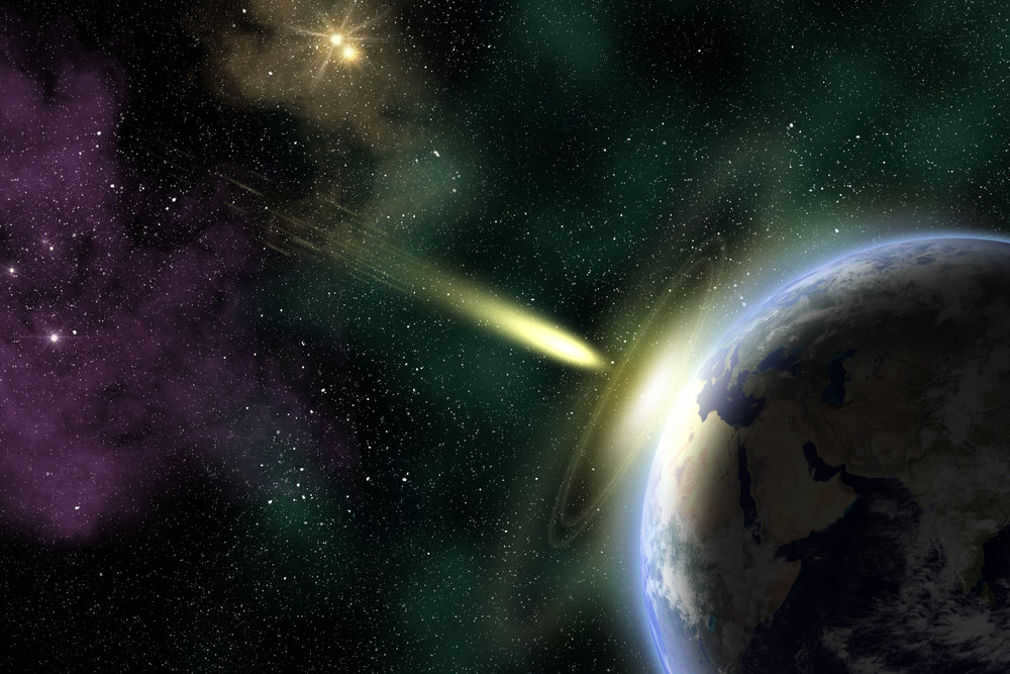
Near-Earth objects have orbits that intersect with the Earth, so when they collide with our planet, the impact is not as devastating due to the reduced velocity. However, comets follow slightly different paths around the Sun, making it extremely challenging to predict their movements. This increases the risk of a direct collision, which could have catastrophic consequences, according to the researchers.
Regrettably, the Earth’s atmosphere cannot provide complete protection against cosmic disasters since comets can reach several kilometers in size. These are massive formations made of rock and ice. When a comet enters the Earth’s atmosphere, its smaller particles vaporize and do not reach the surface, but the larger ones do. Upon impact, they create an explosion that forms a crater. Some scientists theorize that the largest craters on Earth were formed as a result of comet collisions.
The most well-known comets in our solar system
Halley’s Comet
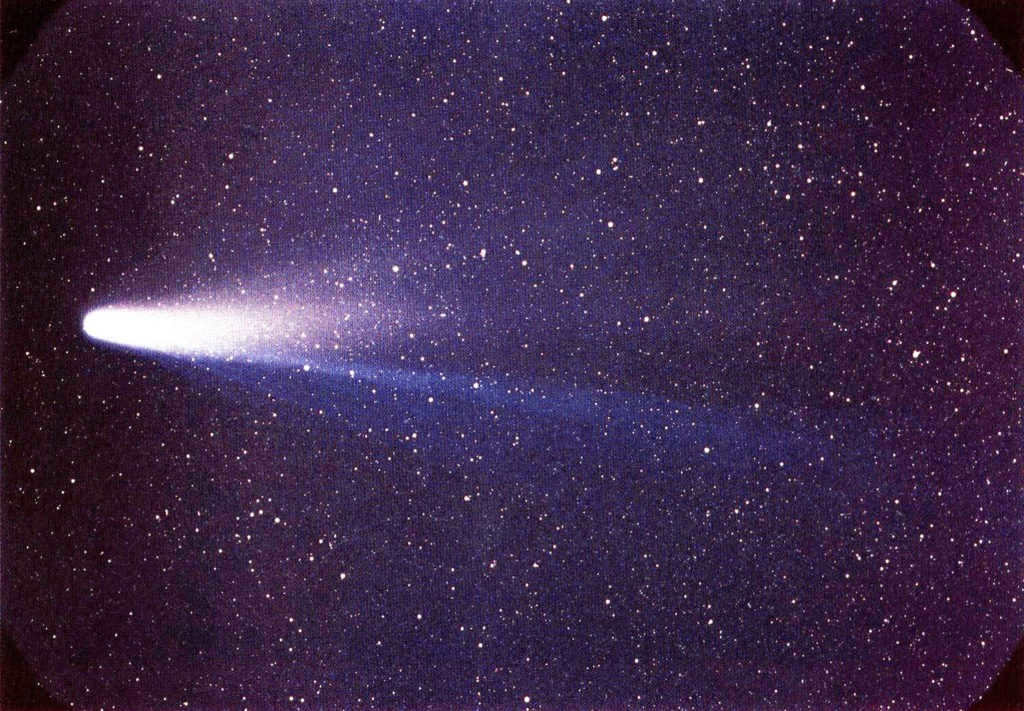

Halley’s Comet is the best-known of all comets. Indeed, Edmund Halley, a British scientist, was the first to successfully demonstrate the periodicity of comets by analyzing data from historical astronomers. He accurately predicted the return of a comet first observed in 1066. Halley’s Comet, which measures 8 km in width and 16 km in length, completes an orbit around the Sun every 75-76 years in an elongated trajectory. Its most recent close flyby of Earth occurred in February 1986.
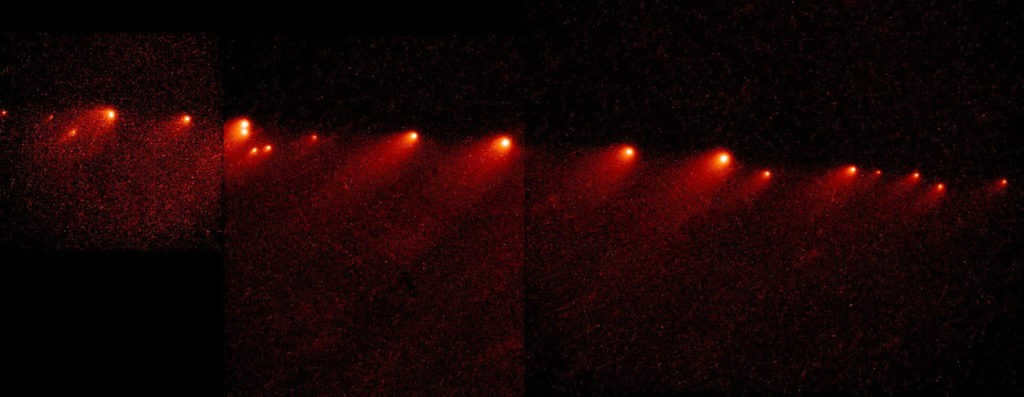
The Shoemaker-Levy 9 comet gained notoriety when it fragmented into 21 pieces in 1992 due to the gravitational pull of Jupiter. In 1994, all of the fragments collided with the surface of the gas giant, creating a spectacular event that captivated both amateur and professional astronomers. It is estimated that the impact of one of the fragments, which measured approximately 3 km in diameter, resulted in an explosion equivalent to 6 million megatons of TNT.
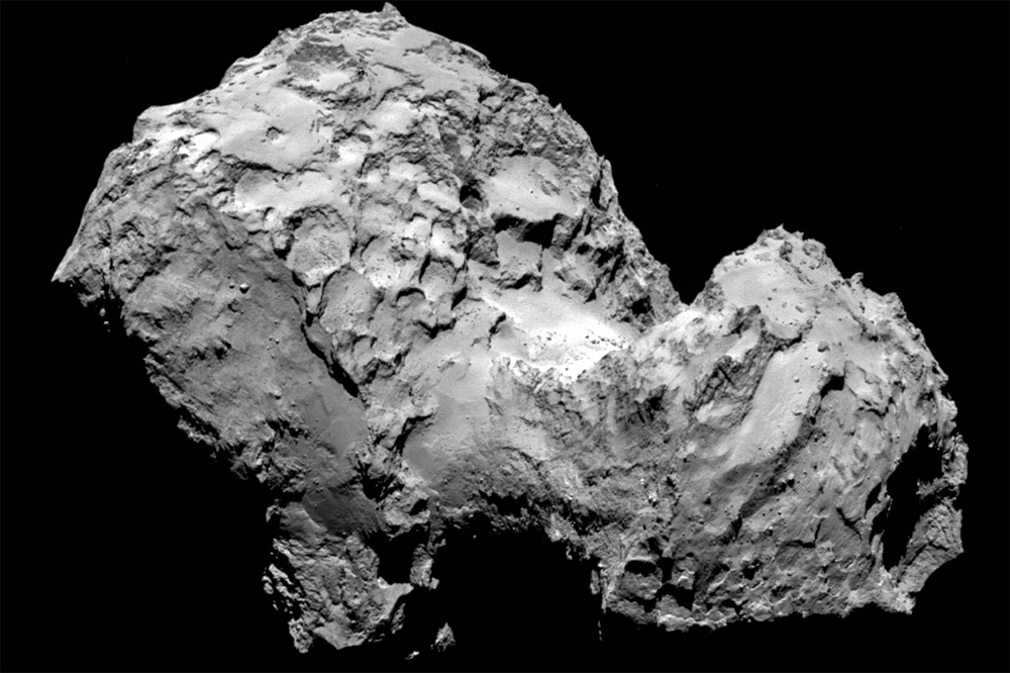
The Rosetta space probe, which was launched by the European Space Agency in 2004, had a planned landing on Comet Churyumov-Gerasimenko in 2014. This comet is estimated to have a width of approximately five kilometers and currently completes an orbit around the Sun every 6.6 years. Originally, its orbit was much larger, but gravitational interactions with Jupiter starting in 1840 caused it to become significantly smaller. As the orbiter made its way back towards the Sun, it had two very close encounters with the comet. The purpose of the probe was to analyze the composition of the comet, providing valuable insights into the formation of our solar system.
Comet Hale-Bopp
The celestial body known as Comet Hale-Bopp is a fascinating astronomical phenomenon that has captured the attention of astronomers and stargazers alike. This comet first made its appearance in the night sky in 1995 and became one of the most widely observed comets of the 20th century. Its distinctive bright nucleus and long tail made it a spectacular sight for those lucky enough to witness it. The discovery of Comet Hale-Bopp was credited to two independent observers, Alan Hale and Thomas Bopp, who both noticed a new object in the sky and reported their findings. This remarkable comet has provided valuable insights into the composition and behavior of these icy bodies that travel through our solar system. Scientists have studied the gases and dust emitted by Comet Hale-Bopp, shedding light on the origins and evolution of comets. It has also served as a reminder of the vastness and beauty of our universe, sparking wonder and curiosity in people of all ages.
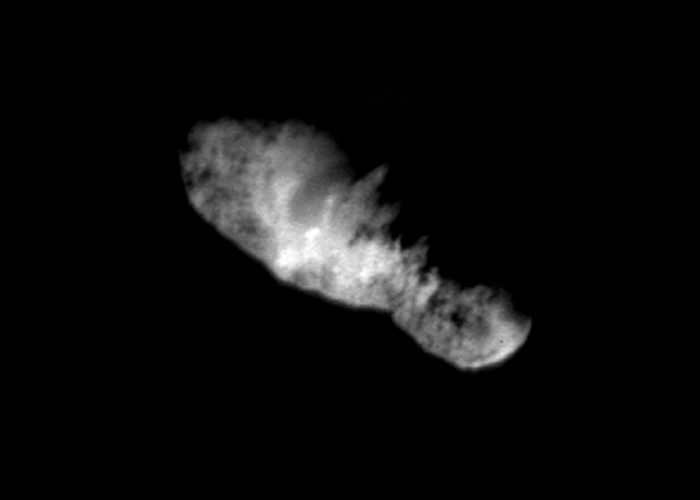
Following the Halley comet, the Deep Space 1 spacecraft, launched by NASA in 2001, captured close-up images of the Borelli comet, marking the second comet to be photographed in such detail. This scientific mission yielded a wealth of information for researchers, allowing astronomers to gain a better understanding of comet nuclei. Analysis of the images revealed that the comet’s core resembled a massive bowling pin, measuring 8 kilometers in length, and the entire body displayed an unusual curvature.
Unlike Halley’s Comet, which originated in the Oort Cloud situated towards the outer reaches of the solar system, the Borelli comet is believed to have originated from the Kuiper belt.
Hyakutake Comet
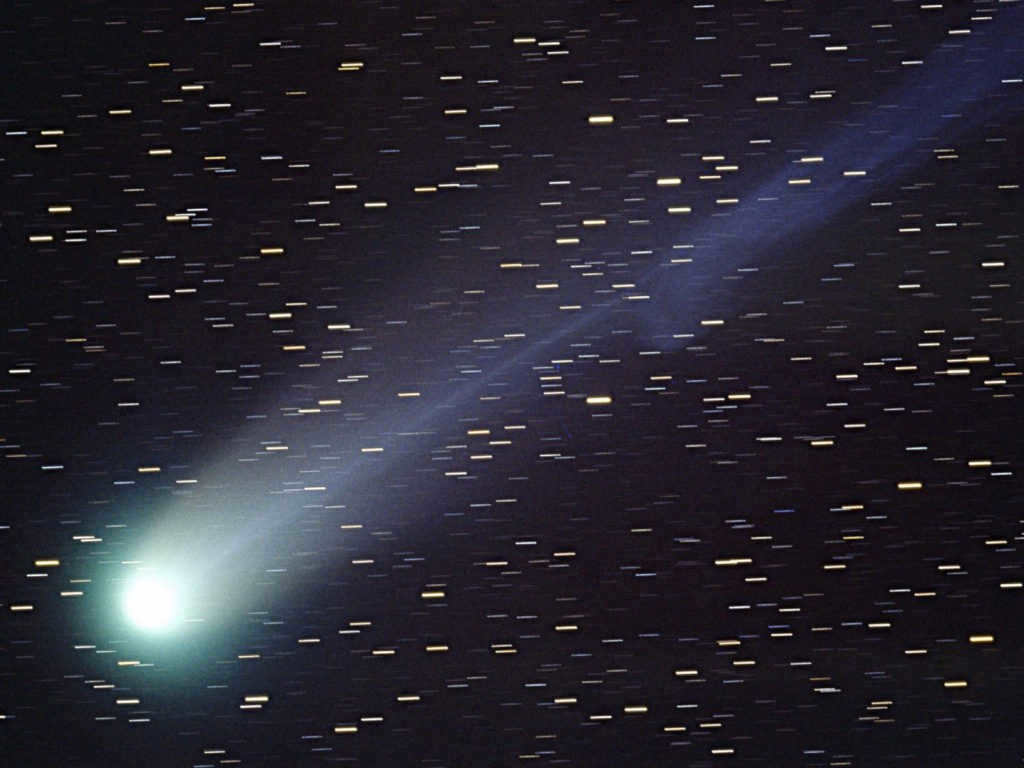
When it passed near our planet in 1996, this comet left a lasting impression on scientists. It came closer to Earth than any other comet, at a distance of only 15 million kilometers. Astronomers were puzzled by the comet’s emission of radiation, which was 100 times more intense than expected.
In May 1996, the Ulysses spacecraft traveled through the comet’s tail and discovered that it was at least 570 million kilometers long. This makes it twice as long as any other known comet.
If you notice an error, please select the text and press Ctrl+Enter.
The vast expanse of space that surrounds us is constantly in motion. As galaxies and star clusters move, other celestial objects, including asteroids and comets, follow a well-defined path. Humans have observed some of these objects for thousands of years. In addition to the Moon and planets, comets often make appearances in our sky. Since their discovery, comets have been observed multiple times, leading to various interpretations and explanations. For a long time, scientists struggled to provide a clear explanation for the astrophysical phenomena that accompany the flight of these fast and bright celestial bodies.
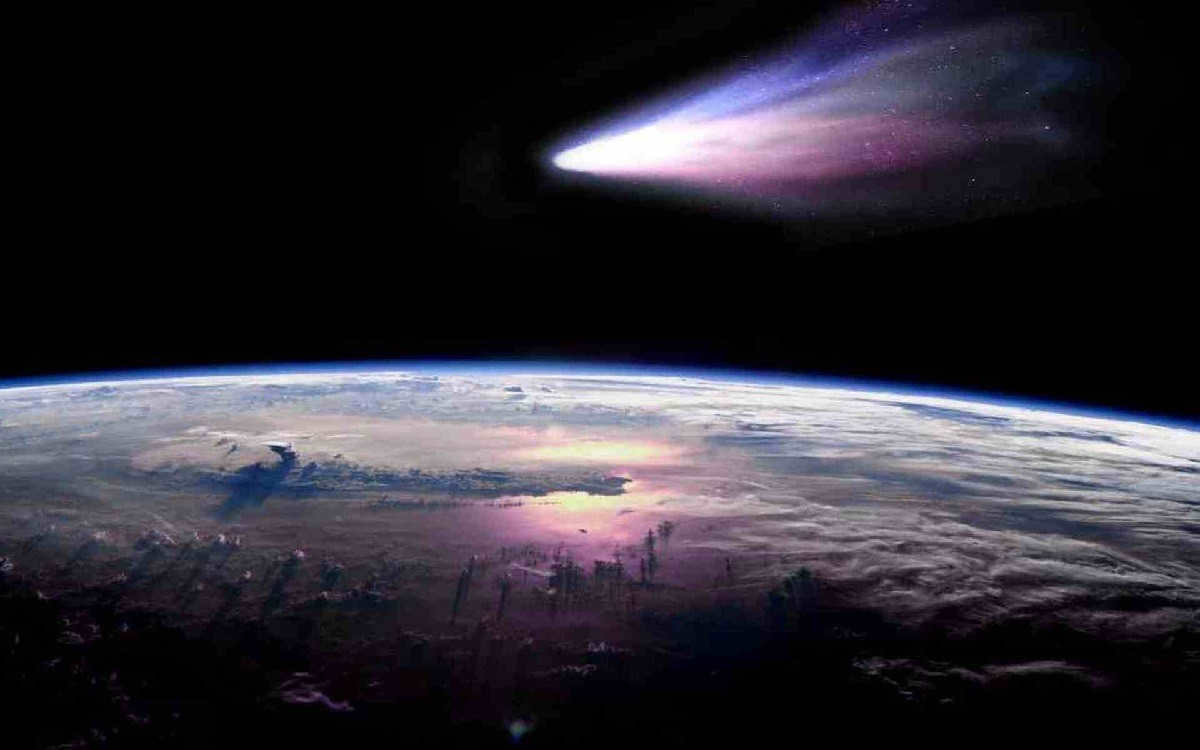
Distinguishing Characteristics of Comets and Their Variations
While comets are a relatively common occurrence in space, not everyone is fortunate enough to witness the sight of a passing comet. This is due to the fact that, in cosmic terms, the trajectory of these celestial bodies is a frequent event. Comparatively speaking, the time it takes for a comet to complete its orbit is quite lengthy when measured in Earth time.
Comets are small celestial bodies that traverse through space towards our Sun, which is the central star of our solar system. Based on observations made from Earth, it has been determined that these objects are all connected to the solar system and were once involved in its formation. Essentially, each comet is a remnant of cosmic material that played a role in the creation of the planets. The vast majority of comets that have been discovered so far are part of our own star system. Like planets, these objects adhere to the same laws of physics, but they have their own unique characteristics and behaviors when it comes to their movement in space.
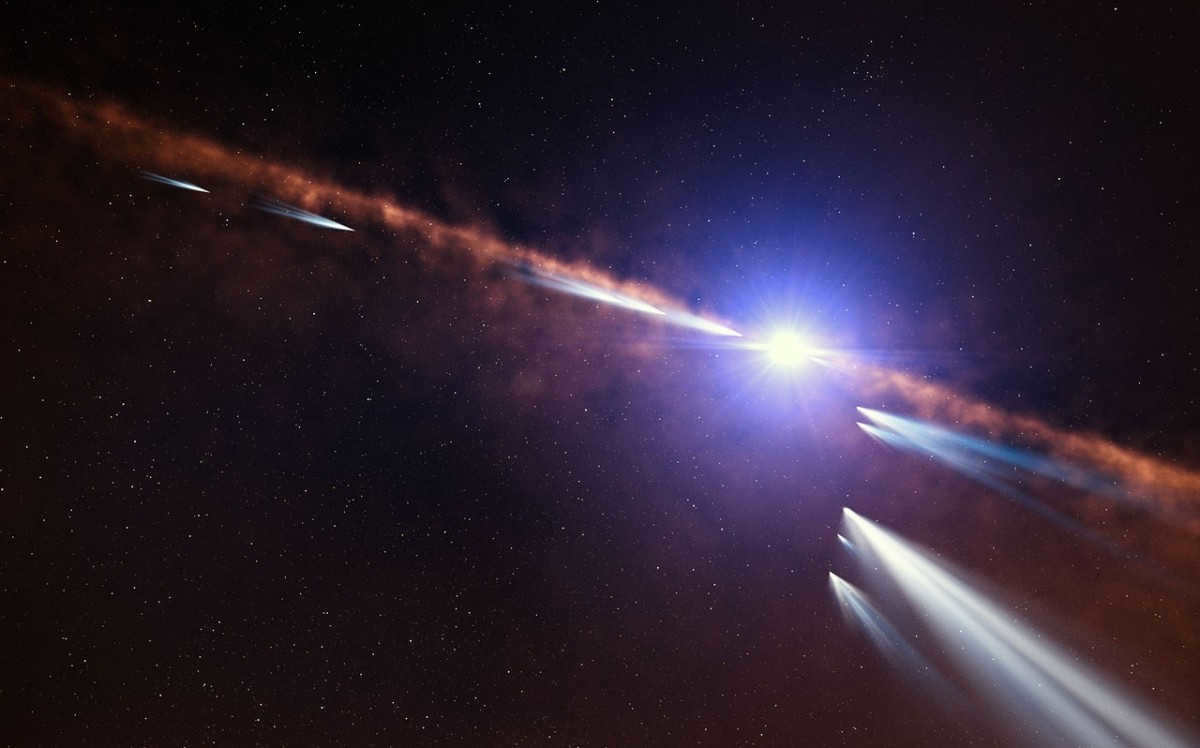
The primary distinction between comets and other celestial bodies is the shape of their orbits. While planets follow circular orbits in the same plane, comets travel through space in a completely different manner. These luminous stars that suddenly appear in the sky can move forwards or backwards, following an elongated (eccentric) orbit. This unique trajectory affects the speed of comets, which is the highest among all known planets and celestial bodies in our solar system, second only to our main star.
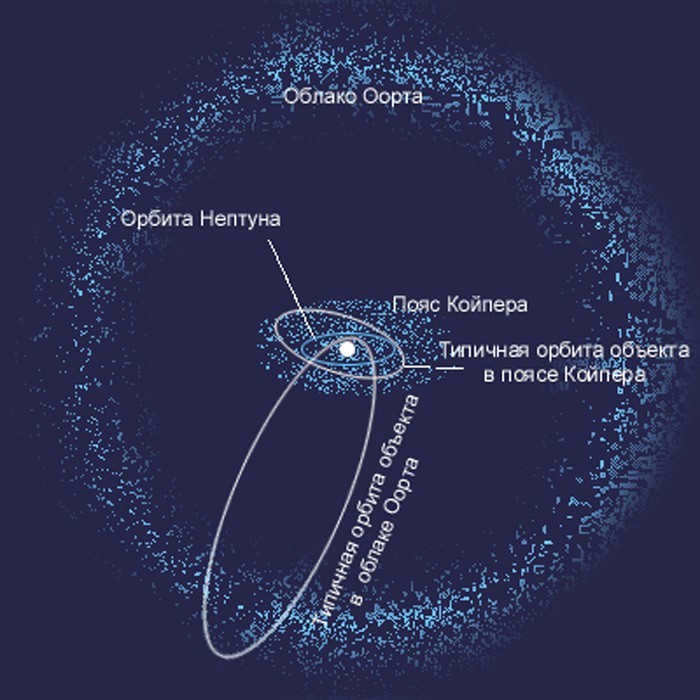
When Halley’s Comet passes near the Earth, it reaches a velocity of 70 km/s.
Furthermore, the orbit of the comet does not align with the ecliptic plane of our solar system. Each celestial visitor has its unique orbit and corresponding period of revolution. This characteristic forms the basis for classifying comets based on their orbital period. There are two main types of comets:
- Short-period comets, with orbital periods ranging from two to a few hundred years;
- Long-period comets, which orbit with periods ranging from two hundred to a million years.
Short-period comets are characterized by their fast movement along their orbit, often designated with the prefix P/ by astronomers. These comets typically have an orbital period of less than 200 years and are the most commonly observed type of comet in our near-Earth space. Halley’s Comet, one of the most well-known comets, completes its journey around the Sun every 76 years. In contrast, long-period comets have much longer orbital periods, ranging from hundreds to millions of years, and are designated with the prefix C/ in astronomy. These comets visit our solar system less frequently, making their appearances a rare and exciting event.
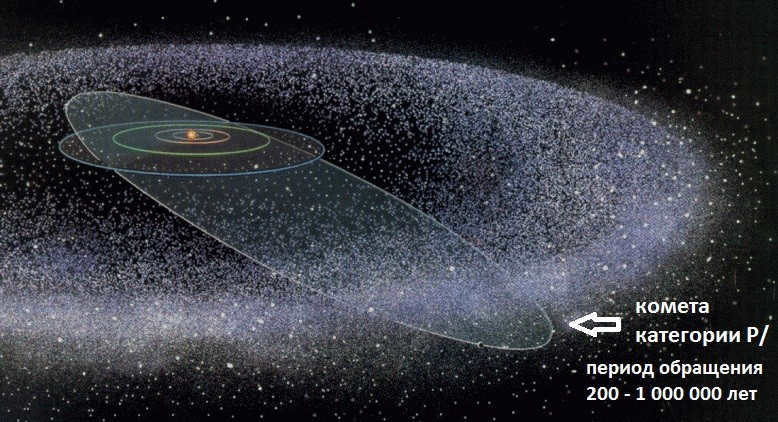
The gravitational force of the major planets in our solar system is believed to have captured short-period comets from the depths of space in the Kuiper belt. On the other hand, long-period comets are larger celestial bodies that originate from the far reaches of the Oort cloud. This region of space serves as the home for all comets that regularly visit our star. Over millions of years and with each subsequent visit to the solar system, the size of long-period comets gradually decreases. Consequently, these comets can transition into the category of short-periodic comets, thereby shortening their cosmic lifespan.
All comets that have been observed in space have been meticulously documented. Scientists have calculated the paths these celestial bodies follow, predicted their future appearances within our solar system, and estimated their approximate sizes. In a remarkable event, one of these comets even demonstrated its own destruction.
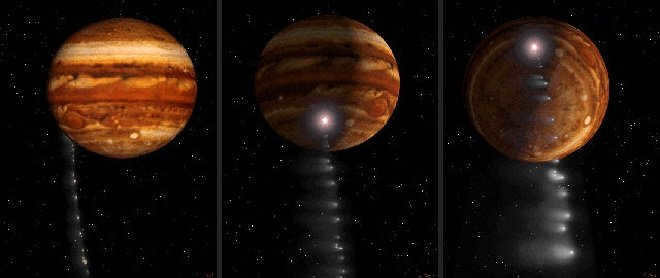
The descent of the short-period comet Shoemaker-Levy 9 onto Jupiter in July 1994 was the most prominent occurrence in the records of studying space near Earth. The comet fractured into pieces near Jupiter, with the largest fragment measuring over two kilometers. The descent of this celestial visitor onto Jupiter extended for a duration of one week, spanning from July 17 to July 22, 1994.
There are currently over 400 known short-period comets that regularly pass by our planet. From the depths of open space, a significant number of long-period comets originate, originating from distances of 20-100 thousand astronomical units from our star. Throughout the 20th century alone, more than 200 of these celestial bodies were documented. Observing such distant objects in a telescope was nearly impossible until the advent of the Hubble telescope. Thanks to this groundbreaking technology, images of far-off regions of space were captured, allowing for the detection of long-period comet activity. These distant objects resemble nebulae adorned with tails stretching millions of kilometers in length.
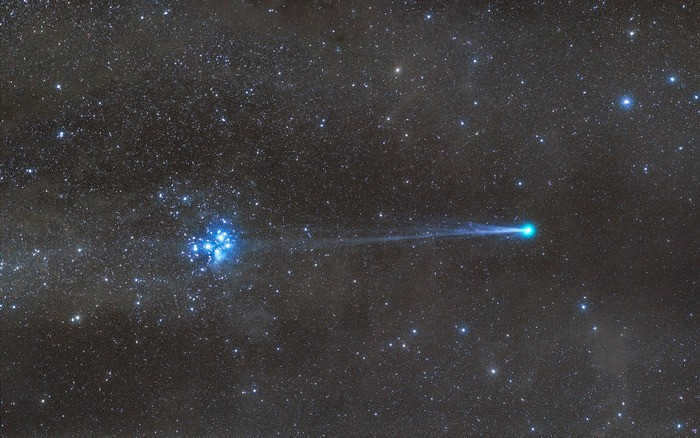
Composition, Structure, and Key Characteristics of Comets
The nucleus of a comet is the primary component of this celestial object. It contains the majority of the comet’s mass, which can range from a few hundred thousand tons to a million. Comets are composed mainly of ice, giving them a dirty appearance when observed up close. The icy nucleus of a comet is a conglomerate of solid fragments of different sizes held together by space ice. Typically, the ice in a comet nucleus is made up of water ice with traces of ammonia and carbon dioxide. The solid fragments consist of meteoric material and can range in size from tiny dust particles to several kilometers.
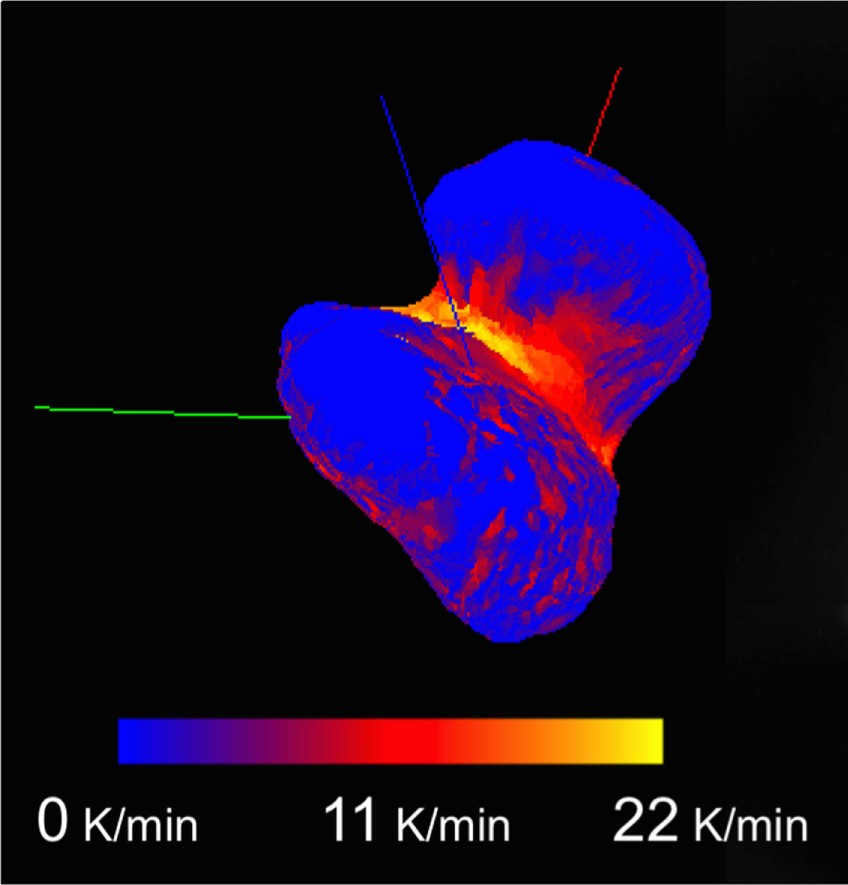
Within the scientific community, there is a widely held belief that comets serve as carriers of water and organic compounds in the vast expanse of outer space. Through an analysis of the nucleus’s spectrum and the gas composition of its tail, it has become evident that these celestial objects are predominantly composed of ice.
The processes that occur during the journey of a comet in outer space are fascinating. While they are at a significant distance from the sun, these celestial travelers are usually not visible due to their strongly elongated elliptical orbits. However, as the comet gets closer to the Sun, it begins to heat up and trigger the sublimation process of the space ice that makes up its nucleus. In simpler terms, the icy core of the comet starts to vaporize without melting. Under the influence of the solar wind, the dust and ice transform into water molecules, creating a coma around the nucleus. This coma can be seen as a kind of corona surrounding the comet, composed of hydrogen molecules. The size of the coma can be enormous, stretching for hundreds of thousands or even millions of kilometers.
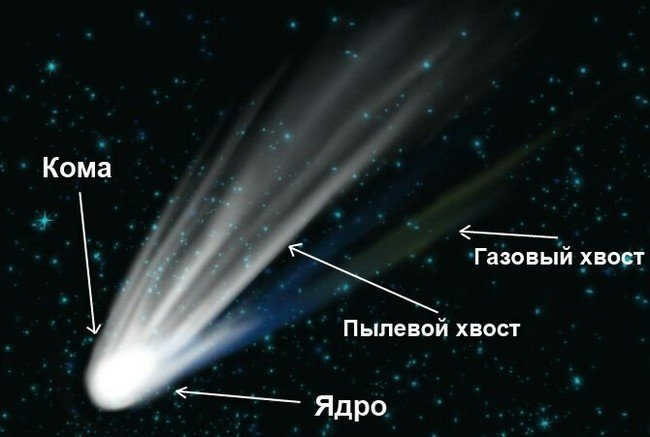
As the comet approaches the Sun, its velocity increases rapidly, causing both centrifugal forces and gravity to come into play. Due to the Sun’s gravitational pull and non-gravitational processes, the particles of cometary matter vaporize and form the tail of the comet. The closer the comet gets to the Sun, the more intense, larger, and brighter its tail becomes, consisting of rarefied plasma. This portion of the comet is highly visible and is considered one of the most brilliant astrophysical phenomena by astronomers on Earth.

Comet History: Observations of Earth’s Celestial Visitors
As our planet orbits the sun, we are witness to a constant stream of space objects passing by, illuminating our sky with their presence. Throughout history, comets in particular have often evoked fear and terror in people. Ancient seers and stargazers associated the appearance of a comet with the onset of dangerous times and planetary catastrophes. Interestingly, while the tail of a comet is only a fraction of its total mass, it is the most luminous part of the celestial body, emitting 0.99% of visible light in the spectrum.

The Great Comet of 1680, also known as Newton’s Comet, was the first comet to be observed using a telescope. Its discovery provided confirmation for Sir Isaac Newton’s theories on Kepler’s laws.
Throughout the study of the celestial sphere, humanity has successfully compiled a catalog of the most common cosmic visitors that regularly make their way to our solar system. Leading the pack is undoubtedly Halley’s Comet – a renowned superstar that has graced us with its presence for the thirtieth occasion. This celestial entity was first spotted by Aristotle. The comet in closest proximity to us earned its name thanks to the endeavors of astronomer Halley in 1682, who meticulously calculated its orbital path and predicted its next appearance in the sky. Our frequent visitor crosses into our field of vision every 75-76 years with unwavering regularity. A distinguishing characteristic of this celestial guest is that, despite leaving a brilliant trail in the nighttime expanse, its nucleus possesses an almost pitch-black surface, reminiscent of an ordinary lump of coal.
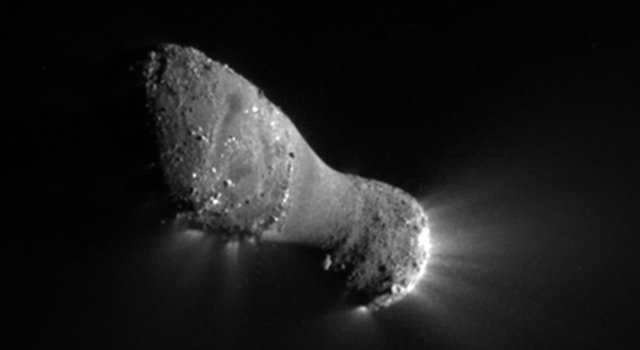

Coming in second place in terms of popularity and fame is the comet Enke. This celestial object has one of the shortest orbital periods, which is equivalent to 3.29 years on Earth. Thanks to this visitor, we have the opportunity to regularly witness the Taurids meteor shower in the night sky.
Other noteworthy comets that have recently graced us with their presence also boast significant orbital periods. In 2011, the Lovejoy comet was discovered, and it successfully ventured close to the Sun without sustaining any damage. This comet falls into the category of long-period comets, with an orbital period spanning 13,500 years. Since its discovery, this celestial guest will remain within the solar system until 2050, after which it will embark on a lengthy 9,000-year journey away from our vicinity.
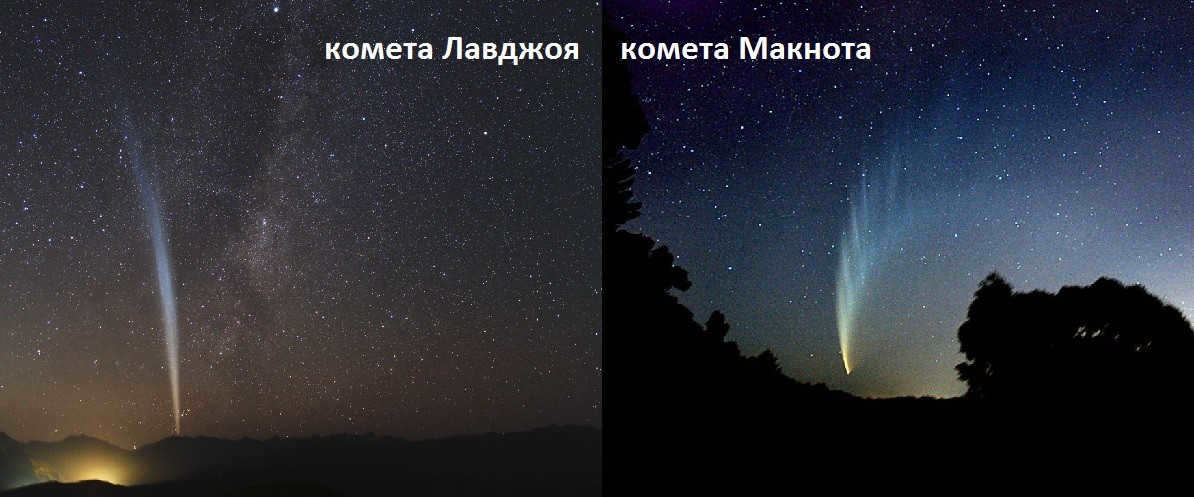
The most remarkable event at the start of the new millennium, both in a literal and metaphorical sense, was the discovery of comet McNaught in 2006. This celestial beauty could be seen even without the aid of telescopes. We will have to wait for another 90 thousand years for the next appearance of this brilliant comet in our solar system.
The next comet that has the potential to grace our skies in the near future is likely to be 185P/Petrew. It is expected to be visible starting from January 27, 2020. In the night sky, it will shine with a brightness equivalent to that of an 11th magnitude star.
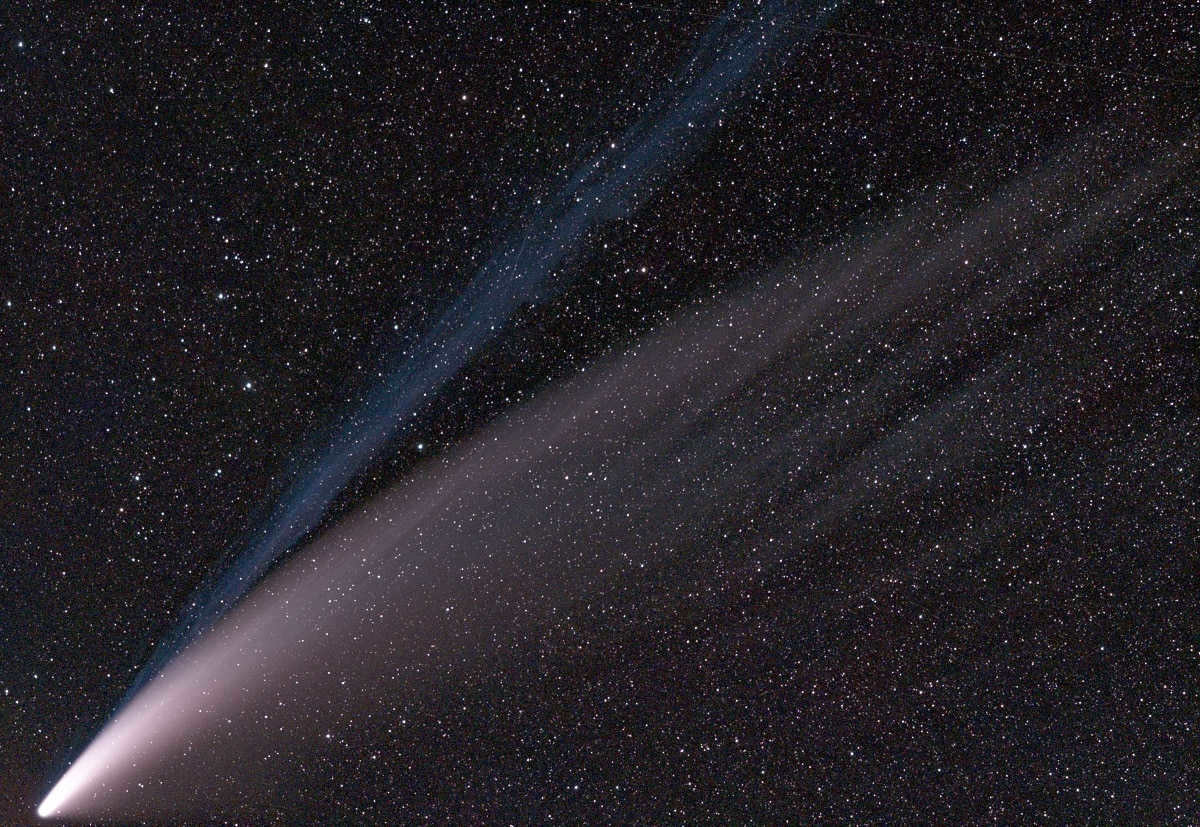
Comets, which are celestial bodies that orbit the Sun, are a fascinating topic in the field of astronomy. These objects, with their unique orbits and durations, originate from either the Kuiper Belt or the Oort Cloud, both of which are regions beyond Neptune in our solar system. However, there is still a lack of understanding about comets and their impact on Earth.
Therefore, the purpose of this article is to provide a comprehensive overview of what comets are, their defining characteristics, their origins, and their significance in the study of our planet.
Understanding the Nature of Comets
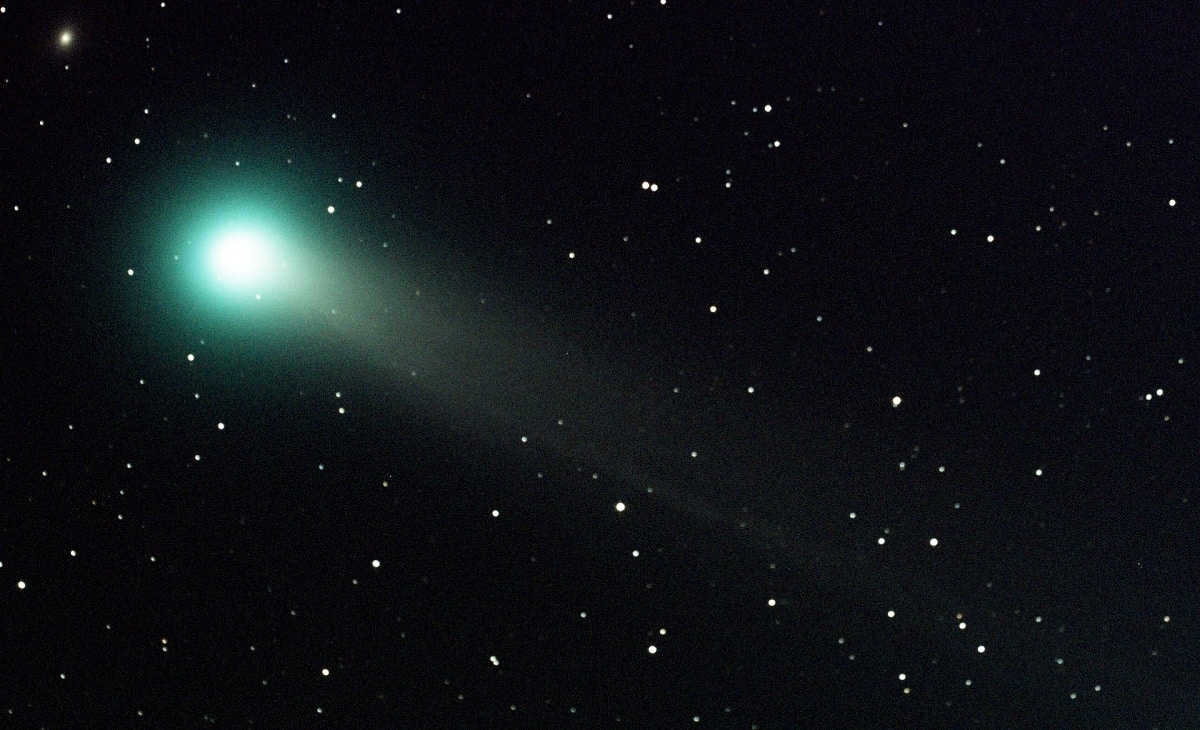
Comets follow highly elliptical paths as they orbit around the Sun, with many of them making a return after hundreds or even thousands of years. They are often depicted as bright oval bodies that leave behind glowing gas trails or comas.
The most well-known comet that can be observed regularly from Earth’s surface is Halley’s comet. However, the study of comets has fascinated astronomers for centuries, especially since the invention of the telescope.
In certain cases, recurring sightings of comets were interpreted as omens, sources of divine revelation, or signs of the end of one era and the beginning of another. Mythological stories such as the biblical Star of Bethlehem may serve as mystical explanations for these celestial wanderers.
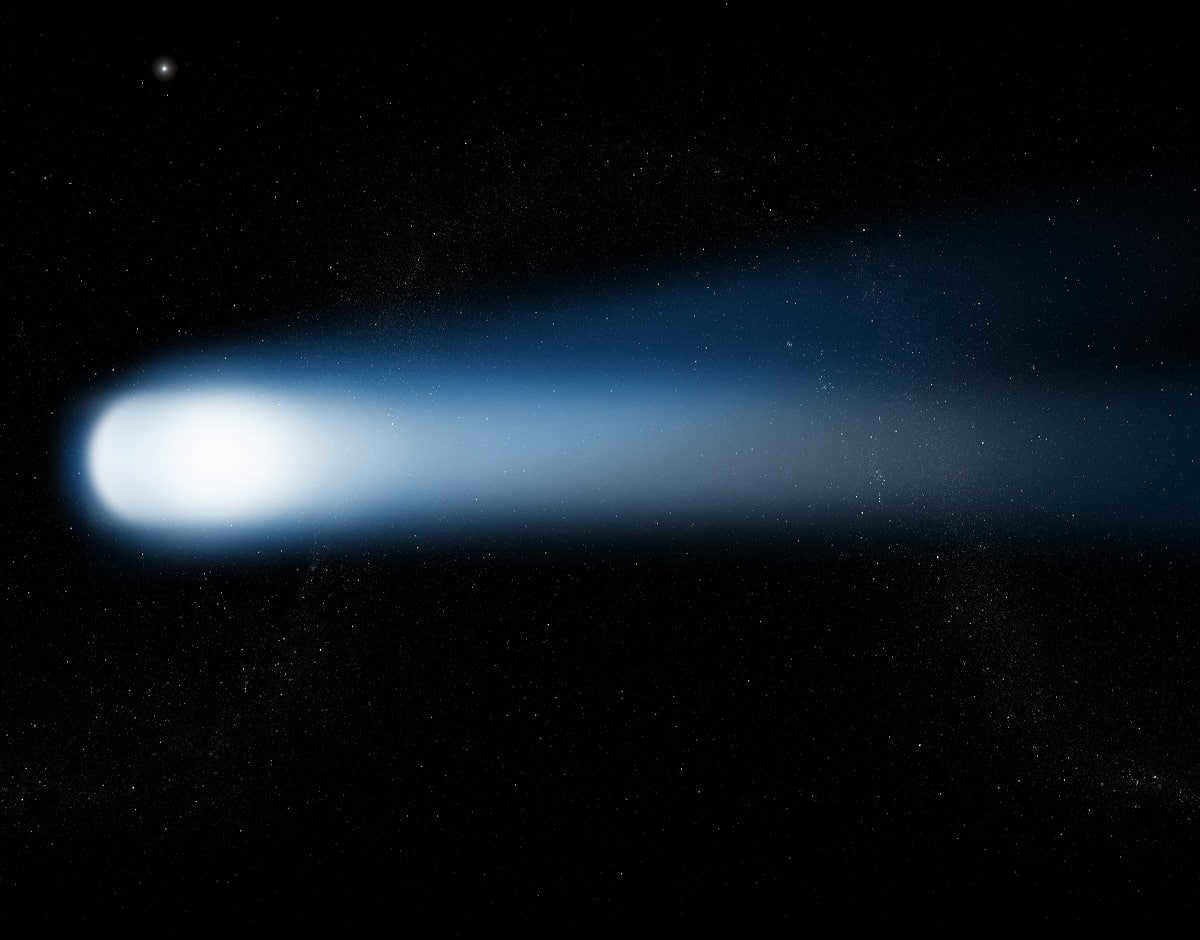
Comets can be categorized using two criteria: their orbital distance and their type of orbit. Let’s discuss the following:
- Short- or medium-period comets. These comets typically come from the Kuiper belt, which is located 50 astronomical units (a.u.) away from the Sun.
- Long-period comets. Comets in the Oort cloud are about a hundred times farther from the outer edge of the solar system.
Similarly, there are two types of comets based on their orbital characteristics: periodic and aperiodic. Periodic comets complete their orbits in 200 years or less, while aperiodic comets start their orbits after 200 years. Additionally, comets can have elliptical, parabolic, or hyperbolic orbits.
Lastly, comets can be classified based on their size into the following categories:
- Dwarf kite: Measures between 0 and 1.5 kilometers in diameter.
- Little kite: Ranges from 1.5 to 3 kilometers in diameter.
- Medium kite: Has a diameter ranging from 3 to 6 kilometers.
- Large kite: Measures between 6 and 10 kilometers in diameter.
- Giant kite: Has a diameter of 10 to 50 kilometers.
- Goliath comet: Measures more than 50 kilometers in diameter.
Components of a Comet
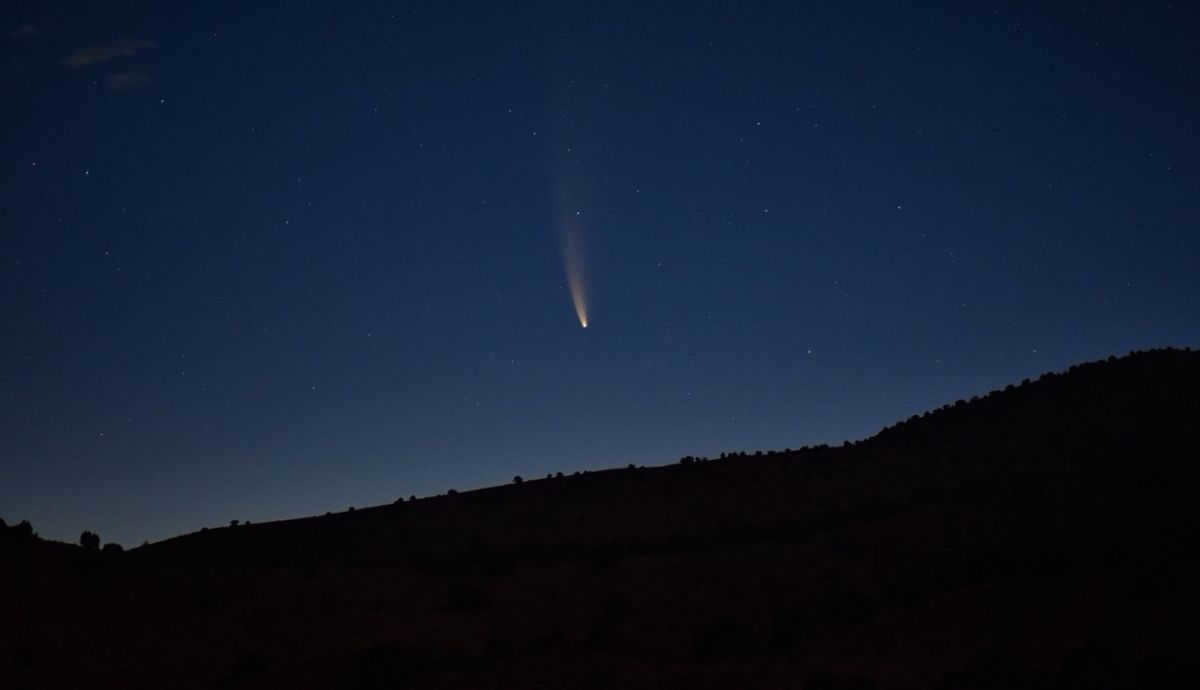
Comets are made up of two distinct parts:
- Nucleus. Comprised of the solid matter of the comet, including ice, inorganic compounds, and traces of hydrocarbons, the nucleus can be thought of as a mobile rock.
- Tail. Also referred to as a coma, the tail is a kilometer-long trail that forms as a result of gas being expelled by the comet when it gets heated by the sun, or from stardust and debris left behind in its path. In some cases, two separate tails can be observed:
- Ion tail. Formed by water vapor expelled by comets, it points in the direction opposite to the sun’s rays.
- Dust comma. Created from solid particles from comets that are suspended in space when our planet enters the Earth’s atmosphere, it produces meteor showers when our planet crosses the path of a specific comet.
Main Characteristics
Comets have various shapes, typically irregular, with sizes ranging from a few kilometers to tens of meters. Their composition is one of the most intriguing mysteries in astronomy, partially unraveled by the most recent close examination of Halley’s Comet in 1986.
We now know that comets contain significant amounts of frozen water, dry ice, ammonia, methane, iron, magnesium, sodium, and silicates. This composition suggests that comets may have been part of the organic matter that contributed to the emergence of life on Earth.
Unique examples of comets:
Here are some of the most well-known comets:
- Halley’s Comet. This is the only comet that is visible on Earth’s surface and it has a cycle of approximately 76 years.
- The Hale-Bop comet. This comet gained a lot of attention in the 1990s and caused many rumors due to its remarkable brightness when it approached Earth in 1997.
- Comet Borelli. Discovered by Frenchman Alphonse Borrelli, this comet was visited by the U.S. Deep Space One space probe in 2001.
- Comet Kojas. This large comet was visible to the naked eye on Earth in 1874. It made two more visits to our planet before disintegrating in 1882.
- Comet Shoemaker-Levy 9. This comet is famous for its collision with Jupiter in 1994, which was the first documented alien encounter in history.
- Comet Hiyakutake was discovered in January 1996 and made its closest approach to Earth that year, marking the shortest distance it had traveled in 200 years. This spectacular event allowed people from around the world to witness the comet’s beauty. Notably, Hiyakutake emitted a significant amount of X-rays, which added to its allure. Scientists estimate that this comet has been in existence for approximately 72,000 years.
Halley’s Comet
Renowned as the most famous comet in the world, Halley’s Comet remains a mystery to many. It is an impressive celestial body that boasts a large size and enough brightness to be observed from Earth. Similar to our planet, Halley’s Comet follows an orbit around the Sun. However, unlike Earth’s annual orbit, Halley’s Comet completes its journey every 76 years, making its appearance a rare and eagerly anticipated event.
Research has been conducted on the orbit of Halley’s Comet since it was last observed from our planet in 1986. This celestial object was named after the renowned scientist Edmund Halley, who first discovered it in 1705. According to studies, it is projected to be visible from Earth again around the year 2061, potentially during the months of June and July.
In terms of its origin, it is believed that Halley’s Comet originated in the Oort Cloud, located at the outermost reaches of our solar system. Within this region, newly formed comets follow elongated trajectories. However, it is speculated that Halley’s Comet experienced a shortened trajectory due to gravitational interactions with the massive gas giants present in our solar system. This is why its trajectory is relatively brief.
Typically, comets with short trajectories are thought to originate from the Kuiper Belt, which is why this region is considered the primary source of Halley’s Comet.





